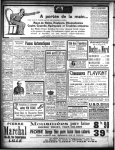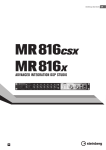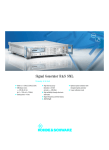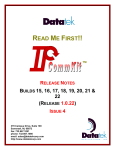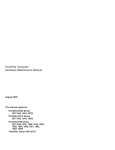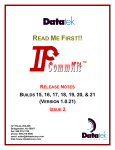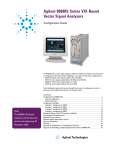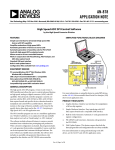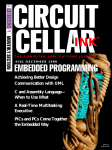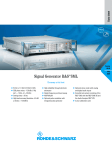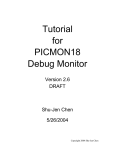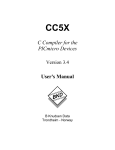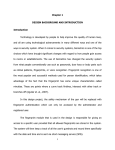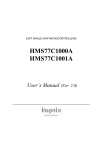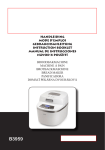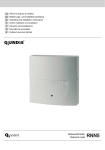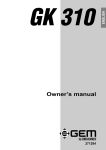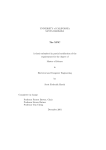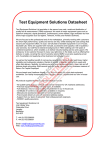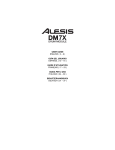Download Wireless Chord Creator for Guitars with Pick-ups
Transcript
Wireless Chord Creator for Guitars with Pick-ups By Edward Michael L. Abad Karen B. Cornejo Rachelle G. Santos A Design Report Submitted to the School of Electrical Engineering, Electronics and Communications Engineering, and Computer Engineering in Partial Fulfilment of the Requirements for the Degree Bachelor of Science in Computer Engineering Mapúa Institute of Technology November 2008 ii ACKNOWLEDGEMENT We, the designers, would like to thank our parents for the support that they have given us in building the design that we have made; all our friends who willingly participated in testing our design effectively; Engr. Cyrel C. Ontimare who has been patient in giving us lectures and recommendations in the making of the design; Prof. Benigno Agapito Jr. who help us in fixing the format for our documentation; Prof. Susana T. Alabastro who patiently guided us in constructing our paragraphs and checking the grammar of our documents; and most especially God, who gave us the strength and patience in constructing our design and our documentation. Edward Michael L. Abad Karen B. Cornejo Rachelle G. Santos iii TABLE OF CONTENTS TITLE PAGE i APPROVAL SHEET ii ACKNOWLEDGEMENT iii TABLE OF CONTENTS iv LIST OF TABLES vi LIST OF FIGURES vii ABSTRACT viii Chapter 1: DESIGN BACKGROUND AND INTRODUCTION 1 a. b. c. d. e. f. g. The Design setting or context or frame of reference Statement of the Problem The Objective of the Design The Significance of the Design The Conceptual Framework The Scope and Delimitation Definition of Terms 1 2 2 2 3 5 7 Chapter 2: REVIEW OF RELATED LITERATURE AND RELATED STUDIES 11 Chapter 3: DESIGN METHODOLOGY AND PROCEDURES 17 Design Methodology Design Procedures a. Hardware Design 1. Block Diagram 2. Schematic Diagram 3. List of Materials Hardware Components b. Software Design Software Components System Flowchart C. Prototype Development 17 17 20 20 21 25 25 28 28 29 30 iv Chapter 4: TESTING, PRESENTATION, AND INTERPRETATION OF DATA Testing the Pre-Set Frequency and LED Testing the Pre-Set Frequency and Guitar with pick-up Testing the Expected Result to Actual Result in the LCD screen Testing the range covered between the Receiver and Transmitter Chapter 5: CONCLUSION AND RECOMMENDATIONS Conclusion Recommendation 32 32 34 36 40 42 42 43 BIBLIOGRAPHY 44 Appendix Appendix Appendix Appendix Appendix Appendix Appendix Appendix Appendix 46 49 58 67 69 71 73 75 80 A Material Listings and Price Lists B Chord Reference C Chords and its corresponding Notes D Data Sheet for LM 567 IC Tone Decoder E Data Sheet for PIC16F877 Microcontroller IC F Data Sheet for Phase–Locked Loop G Data Sheet for LCD Module H User’s Manual I Source Code v LIST OF TABLES Table Table Table Table Table Table 3.1 3.2 4.1 4.2 4.3 4.4 Musical Note Frequency Table List of Materials Function Generator to PLL Calibration Guitar with pick-up to PLL Calibration Guitar with pick-up to LCD displaying the Expected Chord Range of Receiver and Transmitter 18 25 33 35 38 41 vi LIST OF FIGURES Figure Figure Figure Figure Figure Figure Figure Figure Figure Figure Figure Figure 1.1 2.1 2.2 2.3 3.1 3.2 3.2.1 3.2.2 3.2.3 3.3 3.4 3.5 Conceptual Framework XDS95 Screenshot of “Chord Play” S440 Tuner System Block Diagram Schematic Diagram Schematic Diagram for Octave 1 Schematic Diagram for Octave 2 Schematic Diagram for Octave 3 PCB Layout for Microcontroller PCB Layout for PLL Circuit System Flowchart 4 13 14 15 20 21 22 23 24 26 26 29 vii ABSTRACT Wireless Chord Creator using Pick-ups is a portable device that is used to convert notes into chords and display them afterwards. This design is used by guitarists to easily recognize the chords that they have performed. In order for the gadget to work a phase lock loop (PLL) and a PIC microcontroller to display the notes and its equivalent chord are used. The system uses RF through Wireless FM Transmitter and Receiver since it is designed to be wireless for the convenience of the user. Keywords: PIC, notes, chord, cord, octave, guitar, pick-up, tune, strum, pluck, resonance, fret viii Chapter 1 DESIGN BACKGROUND AND INTRODUCTION a. The Design setting or context or frame of reference Chords are the combination of notes that make up a distinguishing sound or tune. In most cases, guitarists whether beginners or professionals make up chords that are hard to explain. There are circumstances when they may have forgotten or cannot explain what they are called because they have just made up these chords accidentally. In order for others to understand what chord is, the guitarist who only made up that chord tries to identify it note by note, but by doing so, consumes much time. Guitar chords are usually published in magazines, songbooks, and even the internet. Other formation of chords is not included in these resources; thus giving the guitarist the freedom to express each chord in his/her own way or technique. When playing the guitar with friends or band-mates, the guitarist might be asked about the chord play. Since the guitarist cannot explain his/her own shape of chords, he/she must go into details for others to understand the chord. There is a need for a device or gadget that will help solve this problem. 1 b. Statement of the Problem Since chords are essential to musicians, it is important to understand easily how chords are made. Guitarists have a tendency to make up chords that sounds like the chord they want to produce but with a different “feel” into it, thus making it hard for them to tell what chord that is. With this gadget, the combination of notes pressed on the guitar fretboard that is plucked or even strummed will be given a clear definition of a chord. c. The Objective of the Design The group aims to create a device that will help guitar players remember the chord they are playing as well as help boost their creativity in making chords. They also considered the following to be able to implement the specified gadget: 1. To be able to interface an RF to the Wireless Chord Creator for it to work at a distance. 2. To be able to convert each combination of notes that is plucked or strummed on the guitar and output it as a chord on a display. 3. To be able to make the design easy to use. d. The Significance of the Design The importance of this study is to provide guitarists or guitar players a guide to the chords they are playing, giving them the idea that the notes they chose is referenced in a real chord. This will benefit guitar players when they are teaching others or even practicing by themselves or with their band due to the ease of knowing the chords they play. It will also lessen the amount of time 2 spent in going into details when explaining a simple chord. This can improve the creativity of a person by enabling him/her to practice each combination of notes that leads into playing a chord. It will help band-mates as well as friends by giving them the idea what chords are used in the song being played. Instead of asking what chords are being played, they will just follow the output sent by the guitar. They may even use a different chord shape that they like. This will be a necessity for guitar players who forget chords. They will just follow the lead of the guitarist and refer to the output the gadget will produce. They can try to make-up their own chord. e. The Conceptual Framework In order to construct the design, the group talked about certain ideas related to this study. After the brainstorming session, each member agreed on one thought which resulted in one concept. Figure 1.1 illustrates the flow on which the device will work. It covers the three major parts such as the Input, Process and Output. It is a brief overview of the features of the device. 3 INPUT PROCESS OUTPUT A switch is pressed to initiate a capture time. Oscillation of string produces sound waves received by the guitar pick-up. The output is then sent to the LCD to display the notes hit. Note(s) are plucked or strummed and is received by the guitar pick-up while capture time is running. Sound is then converted into a signal from the PLL(Phase Lock Loop) giving an absent or present signal. After the capture time, the chord is shown in the LCD to which it has the corresponding combination of notes. Signal is then processed in the microcontroller to produce a chord. Figure 1.1: Conceptual Framework Concept Model Using the concept model found on Figure 1.1, the design shows that when a note or a combination of notes is strummed or plucked, it will be received by the guitar pick-up. Before plucking or strumming the strings, the switch should be set first to have ample time to capture the notes. The signal then travels to the device PLL (Phase Locked-Loop) which process the audible signal in an absent or present state like a digital signal either as 0 or 1. The process of deciphering the chord by means of the combination of signals (notes) will take place in the microcontroller and will output a signal that is sent to the LCD display, which is not attached to the gadget. It can also be placed at a distance estimated to be within a typical room size for the user to see it from afar. The LCD with the main board can be attached to the guitar itself or placed at a certain distance not greater than 10m for other users to see the chords being 4 played. The LCD then shows the output of the notes with the chords the user has just played. f. The Scope and Delimitation The device covers and delimits to the following: Scope 1. The device will use RF technology. 2. It can be easily attached or un-attached to a guitar. 3. The output will be displayed on a LCD screen. 4. The gadget will have two separate parts; one part is for the display (LCD) as well as the main board for the processing of signals, the other part is for the output of the guitar that will send the signal to the main circuit. 5. The amplifier connected to the transmitter has an added slot wherein you can connect a microphone cable on one end and the other end to an amplifier system if the user wishes to. 6. A push-button switch is used to trigger the start of processing of the system design. 7. It will use the PLL (Phase Locked-Loop) principle. Delimitation 1. It can only be used for a guitar with a guitar pick-up. 2. The design cannot show the positioning of notes to be pressed as a chord is played. 5 3. It cannot be submerged in water or any form of liquid. 4. It is more accurate if the guitar and strings are in good working condition. 5. The guitar should be in standard tuning to have better results. 6. The circuit only covers 3 octaves from 110 Hz (A Note) to 830.6094 Hz (G# Note). 7. Chords created are only the common chords used; Major, Minor, Suspended, Seventh, Major Seventh, Minor Seventh, Diminished, and Augmented. 8. It is battery operated. 9. Its wireless capability is up to a maximum of 10 meters. 10. The main board is connected to the LCD screen by means of a cable of 2 meters. 11. The transmitter must be set to 107.1 MHz since it is the pre-set default frequency; thus, it can be varied if the receiver is calibrated again in synchronization with the transmitter. 12. The main board only uses 1 rocker switch for the On/Off of the power supply. 13. It cannot output multiple chords at a time. 14. It only has a capture time of 8 seconds. 6 g. Definition of Terms 1. Amplifier - sound-increasing apparatus: a device that makes sounds louder, especially one increasing the sound level of musical instruments (Encarta® World English Dictionary). 2. Chords - notes struck together: two or more musical notes played or sung simultaneously (Encarta® World English Dictionary). 3. Circuit - route for electricity: a route around which an electrical current can flow, beginning and ending at the same point (Encarta® World English Dictionary). 4. Cord - electrical cable: flexible insulated electric cable (Encarta® World English Dictionary). 5. Frequency - rate of recurrence: the number of times that something such as an oscillation, a waveform, or a cycle is repeated within a specific length of time, usually one second (Encarta® World English Dictionary). 6. Fret (Fretboard) - any of the ridges of wood, metal, or string, set across the fingerboard of a guitar, lute, or similar instrument, which help the fingers to stop the strings at the correct points (Chicago Manual Style). 7. Gadget - ingenious device: a small device that performs or aids a simple task (Encarta® World English Dictionary). 8. Guitar - stringed musical instrument: a musical instrument with a long neck, a flat body shaped like a figure eight, and usually six strings that are plucked or strummed (Encarta® World English Dictionary). 7 9. Guitar Pick-up - A guitar pickup, also called transducer that converts the vibrations of guitar strings or the guitar body to an electrical signal (Musician News). 10. LCD – Liquid Crystal Display, an electronic display (as of the time in a digital watch) that consists of segments of a liquid crystal whose reflectivity varies according to the voltage applied to them (Merriam-Webster). 11. Microcontroller - a microprocessor that controls some or all of the functions of an electronic device (as a home appliance) or system (Merriam-Webster). 12. Music - sounds that produce effect: sounds usually produced by instruments or voices that are arranged or played in order to create an effect (Encarta® World English Dictionary). 13. Note - musical or vocal sound: a sound of a distinct pitch, quality, or duration produced by a musical instrument or by the voice (Encarta® World English Dictionary). 14. Octave - note at each end of octave: the note at each end of an octave, especially the higher one, considered in relation to the note at the other end (Encarta® World English Dictionary). 15. Phase - part of repeating cycle: a part of a repeated uniform pattern of occurrence of a phenomenon or process, relative to a fixed starting point or time (Encarta® World English Dictionary). 8 16. Pluck - pull and release strings: to play a stringed musical instrument by quickly pulling and releasing strings with a finger or plectrum (Encarta® World English Dictionary). 17. Resonance - large oscillation at natural frequency: increased amplitude of oscillation of a mechanical system when it is subjected to vibration from another source at or near its own natural frequency (Encarta® World English Dictionary). 18. Signal - transmitted information: information transmitted by means of a modulated current or an electromagnetic wave and received by telephone, telegraph, radio, television, or radar (Encarta® World English Dictionary). 19. Sound - reproduced music or speech: the music, speech, or other sounds heard through an electronic device such as a television, radio, or loudspeaker, especially with regard to volume or quality (Encarta® World English Dictionary). 20. String - cord stretched across musical instrument: a cord made of nylon, wire, or gut that is stretched across a musical instrument and plucked, bowed, or otherwise vibrated to produce sound (Encarta® World English Dictionary). 21. Strum - play instrument by brushing strings: to play a guitar or other stringed instrument by brushing the strings with the fingers or a pick (Encarta® World English Dictionary). 9 22. Technology - application of tools and methods: the study, development, and application of devices, machines, and techniques for manufacturing and productive processes (Encarta® World English Dictionary) 23. Tune - adjust instrument for pitch: to adjust a musical instrument so that it plays at the correct pitch (Encarta® World English Dictionary). 24. Wireless - using radio signals: using radio signals rather than wires (Encarta® World English Dictionary). 10 Chapter 2 REVIEW OF RELATED LITERATURE AND RELATED STUDIES The concept of making this type of system design was brought up when the designers came across certain studies while conducting the research. They worked together on the ideas of existing studies and utilize them in their design. An article by Peter Gitundu in Music, Recreation and Leisure, Art and Culture magazine entitled, “Why You Should Be Using An Electronic Tuner Today” stated that when a guitar is tuned up, the stress tension is changed on one string at a time. This tuning applies to all strings whether one is using an electronic guitar or not. Nylon strings may just take a little more effort to settle into tune. This is a significant information because it means that a certain string corresponds to a certain tension. A tension will lead to how much the string or group of strings oscillate that will produce a unique frequency that can be based on a reference. It is necessary to know the key in which the guitar needs to be tuned. Normally for a 6-string guitar basic keys of EADGBE are used. Hence if you need to tune the guitar in standard form, it is not necessary to change tuning keys because it sounds in EADGBE. These notes or keys can be adjusted by tightening or loosening each string. An electronic tuner makes tuning very much easier. This principle can be applied to the design since chords are a combination of notes, and in order for one to determine a note a tuner is needed. If a string is strummed or plucked, 11 guitar’s knobs can be turned on until the guitar strings match with the corresponding pitches of the instrument. The article helped the designers to conceptualize that tuning instruments have a reference which can be called a “standard”. This means that one note must be in the same frequency caused by the tension of the string of the same note but with a different instrument. It also emphasizes that electronic tuners are much easier to use thus giving the designers a push to pursue the creation of an electronic device. Wireless technology is the approach used in the design. Making the device use this type of technology broadens the scope of the design. In an article published in the Modern Guitars Magazine (January 9, 2007), X2 Digital Wireless, Inc. announced that the XDS95 is the first and only digital multi-channel digital UHF wireless system designed specifically for performing or recording musicians and is now shipping through authorized dealers. This gadget uses digital RF modulation, hence the idea of using RF technology is one of the options. Since the XDS95 is advertised as the first and only wireless system for musical applications, no other device in the music industry have the same approach; thus giving the proposed design a slight edge. Figure 2.1 shows the XDS95 which comprises of two parts: the receiver and the transmitter. Since it uses RF technology, it is a given that these two parts are needed to make gadget work. 12 Figure 2.1: XDS95 The chord plays a vital role in making the device. It is necessary that the said tool can output an expected chord. The article by Jody Mitoma of Touch Podium entitled, “‘Chord Play’ Lets You Play up to 12 Guitar Chords at Any Given Time” (August 20, 2008) is about computer software, which lets you play guitar chords on your iPhone and iPod Touch. It is done by simply tapping on the chords you want to play and then use the six strings to play the notes of the chord as you would on a guitar. The chord creator lets you define and save even more chords. This kind of software lets you define the chord you want to produce. This information helped the designers figure out the main features of the device. The chords the user defines in the guitar will be displayed on a screen. This will give the user the freedom to create new chord positions he/she want to use. Figure 2.2 shows the software display in use. It features defining a chord by means of showing the notes on the top center of the screenshot which gives the designers an idea on how to present the output of the device. The 13 group figured out that the output should display the notes of the chord as well as the main part which is a chord. Figure 2.2: Screenshot of ‘Chord Play’ Mounting the device is one of the group’s discussions wherein different ideas came into play. An article by Conner Flynn on Peak (January 11, 2008), entitled “eNote Clip-On Digital Chromatic Tuner” discussed the use of a clipping device. It’s as simple as to just attach the little device to the guitar or other instrument and the display will show up green once the note is correct. Clipping the mechanism to the instrument made it easy to use. The idea of using an LCD screen for the device was inspired by the article by Lou Reade of Innovative Engineering Device (October 21, 2007). The article is 14 about a product launched at the Frankfurt Music Show that helped guitarists to solve one of their greatest headaches, tuning. The device, the S440 tuner, was developed by Somerset-based ATD. It displays the output on a LED screen. Since Maxon Motor UK developed the product based on LED, an LCD screen was used in the proposed design for a clear and elegant display. Figure 2.3 shows the S440 Tuner that is attached to the guitar. Its display can be seen on a LED screen, while its output will be incorporated on a LCD screen. However, a larger screen will be used so that other essential information could be squeezed in. Figure 2.3: S440 Tuner Microcontrollers are very popular in implementing electronic devices. This concept was applied to the design since it is widely used in most parts of the country. An article by Ariz Chandler of CPU Technologies (March 3, 2003), entitled “New Microchip PIC16 New Low-Power Microcontrollers with nanoWatt Technology” described the great features of the new microchip PIC16 that will boost the performance of such a device. It offers the flexibility of reprogrammable Flash memory coupled with new power management features, and are designed to reduce the overall power consumption in embedded 15 systems. This feature of the PIC gives a solid foundation of components to make the design possible. The IC is affordable and easily available here in the Philippines. This information is important as it makes the design possible. 16 Chapter 3 DESIGN METHODOLOGY AND PROCEDURES Design Methodology Wireless Chord Creator for Guitars with Pick-Ups is a system design that provides guitarists or guitar players ease of determining the chords they are playing. This design is the first of its kind since other guitar related devices which are guitar tuners name only one note to be played. Applied research was used to solve practical problems that relate to this kind of study. This form of research is necessary to improve on this field of technology. Inquiries from other people as well as using books as references are key methods of understanding the problem itself. With this, one’s knowledge about this area of study can broaden and open to new ideas to enhance the gadget. Rigorous reading from different sources such as books, magazines and other materials contribute to a better understanding of the subject at hand. Having all the information formulates in the development of the actual device. Data attained by the group is utilized to create such a device. Design Procedure for Actual Design The designers have taken a step by step procedure in making the whole hardware design. These steps are as follows; 1. The first step was to gather information from related studies to have adequate background of the area of the study. It is vital to know other information related to the study because it will help in the understanding of 17 the concept of the design. Conceptualization was also done in this part by brainstorming among the members of the group. One of the key data gathered was the Musical Note Frequency Table shown in Table 3.1 below. Key Notes 1 2 3 A 27.5 55 Bb 29.14 58.27 B 30.87 61.74 C 32.7 65.41 C# 34.65 69.3 D 36.71 73.42 D# 38.89 77.78 E 20.6 41.2 82.41 F 21.83 43.65 87.31 F# 23.12 46.25 92.5 G 24.5 49 98 G# 25.96 51.91 103.83 4 110 116.54 123.47 130.81 138.59 146.83 155.56 164.81 174.61 185 196 207.65 5 220 233.08 246.94 261.63 277.18 293.66 311.13 329.63 349.23 369.99 392 415.3 OCTAVE 6 7 440 880 466.16 932.33 493.88 987.77 523.25 1046.5 554.37 1108.73 587.33 1174.66 622.25 1244.51 659.26 1318.51 698.46 1396.91 739.99 1479.98 783.99 1567.98 830.61 1661.22 8 1760 1864.66 1975.53 2093.01 2217.46 2349.32 2489.02 2637.02 2793.83 2959.96 3135.96 3322.44 9 3520 3729.31 3951.07 4186.01 4434.92 4698.64 4978.03 5274.04 5587.65 5919.91 6271.93 6644.88 10 7040 7458.62 7902.13 8372.02 8869.84 9397.27 9956.06 10548.08 11175.3 11839.82 12543.85 13289.75 11 14080 14917.24 15804.27 16744.04 17739.69 18794.55 19912.13 Table 3.1 Musical Note Frequency Table A particular key or note corresponds to a specific value. Each value in the table is in Hertz (Hz). This is essential because it will distinguish one note from another wherein a chord is a combination of specific notes. 2. Second, the group researched on the ideal or suggested components or parts they can use in doing the design. The group also considered the availability and cost of the components they will use. 3. After canvassing the components to be used, the third step is to design the flowchart was designed to have an overview of how the device will work. 4. Designing the schematic and circuit diagram was conducted. This was based on the information about the availability of the needed components. 18 5. PCB designing was made. The components were then integrated to the PCB following their connections from the schematic and circuit diagram. 6. Testing was then conducted after making sure each connection was properly placed. The testing procedure verified if the expected results would occur. 7. If there were still problems, troubleshooting of the design or making other adjustments until the projected results would appear. 8. After this process was made construction took place. 9. Once everything has been completed, a final test with the gadget was made just to make sure everything goes out according to plan. 19 Hardware Design 1. Block Diagram Figure 3.1: System Block Diagram Figure 3.1 shows an illustration of the System Block Diagram for the system design. 20 2. Schematic Diagram Figure 3.2: Schematic Diagram for the main circuit 21 Octave 1 Figure 3.2.1: Schematic Diagram for Octave 1 22 Octave 2 Figure 3.2.2: Schematic Diagram for Octave 2 23 Octave 3 Figure 3.2.3: Schematic Diagram for Octave 3 24 3. List of Materials Description Quantity Description Quantity LCD module 16 character x 2 Line 1 LED 37 Mini Push Button 1 LM567 IC 36 8 pin connector 2 LM358 IC 3 Heatsink 1 Alexan Case Black 1 1200uF/16V electrolytic capacitor 1 Alexan Case White 2 100uF/25V electrolytic capacitor 1 Battery Holder 1 105 multilayer ceramic capacitor 1 Battery AA 8 22pf ceramic capacitor 2 Phone Jack 1 W10G Bridge Diode 1 Rocker Switch 1 1/4Watt resistor 94 IN4148 Diode 36 2 pin terminal block 2 Trimmer resistor 100K 36 4Mhz Crystal 1 8 pin IC Socket 39 10K array resistor 2 FM Receiver 1 40 pins IC Socket 1 Phone Jack Y-adaptor 1 PIC16F877 microcontroller IC 1 Phone Jack converter 1 104 Multilayer ceramic capacitor 48 Microphone Amplifier 1 10uF/16V electrolytic Capacitor 36 Microphone Cable 1 47uF/16V electrolytic Capacitor 36 9V Battery 1 Wireless FM Transmitter 1 bag 1 Table 3.2: List of Materials Hardware Components Research was conducted on for the most effective electronic parts for this system design. Some important components of the design are listed below. 25 PCB Layout Figure 3.3: PCB Layout for Microcontroller Figure 3.4: PCB Layout for PLL Circuit 26 Micropower Phase-Locked Loop Since the design system relies on frequency as an input, the Micropower PLL is the best device for the system design. Micropower Phase-Locked Loop is a device that compares the frequencies of two signals and produces an error signal which is proportional to the difference between the input frequencies. This device will be responsible for receiving and converting the frequency inputted through strumming of the guitar strings. It will output either absent or present which will be passed to the microcontroller as 1 or 0. Each note from three different octaves is embedded with one PLL. LCD Module The LCD was used for displaying the output of the system design. The data to be displayed will come from the microcontroller. The LCD will only display the type of chord played by the guitar player. If the input signal is invalid the LCD will display a “Try Again” message. The LCD will also display the countdown of 8 sec. time limit for capturing the frequency of the notes played by the user of the guitar. Radio Frequency using Wireless FM Transmitter and Receiver A Wireless FM Transmitter and Receiver were used in order to transmit the input signals created by the guitar to the system design. This device was used to create a wireless connection from the guitar to the system design. This was implemented to provide convenience and allowed the guitarist to move at a maximum distance of 10 meters. It is also possible for other users to utilize a 27 guitar at a certain area in the room and be able to supply an output for the other player to show the chord that user has created. Software Design The system designers needed a device for the capturing process and producing the chord created from the strumming of the guitar. A push button was implemented to initiate the capturing process. As a solution, a microcontroller was used to control the capturing process and to produce the chord created. The microcontroller was used to compare and interpret the converted signals passed by the PLL. The main routine of the program is to capture and produce the chord created by the guitar player. The output is then sent to the LCD to display the created chord. Software Components The main software component of the design is the PIC16F877A microcontroller. It is the one responsible for operating the whole system. The converted input from the PLL is passed to the microcontroller to produce chords created. For the program language, the PIC Assembly was used to program the microcontroller. PIC Assembly is much similar to Assembly Language especially in some of its instructions. This language is one of the simplest way to program a microcontroller device. 28 System Flowchart Figure 3.5: System Flowchart 29 Prototype Development The following statements summarize the development of the Wireless Chord Creator for Guitars with Pick-Ups. 1. During the first part of the term, the group proposed a project about a device to display the chords created in a guitar. This idea was made possible through research from books, magazines and other materials. 2. Data gathering of related literature and related studies was needed after proposing the project to collect more information to the developers. 3. Research was conducted on how the major components of the device work. The availability and cost of each component were also considered. These components are as follows; a) Phase-Locked Loop b) Software programs c) LCD Module d) Radio Frequency Principles e) Microcontroller 4. A flowchart was planned and designed to have an overview of how the device will work. 5. The schematic diagram was then created in reference with the flowchart. This is necessary since the flowchart gives a graphical representation of the functions of the device. If the functions are enumerated, the components can then be set depending on which is needed. 30 6. Using all the information in the schematic diagram, a PCB layout was created. Then the components were then interfaced with each part. 7. The device was tested using a function generator to know if the expected outputs were achieved. The circuit was also calibrated to be set to its purpose. 8. When the setting was completed, the circuit was tested by means of a guitar with pick-ups. This determined if the expected output was correct. 9. When testing was successful, construction of the casing was started. 10. After the completion of the casing, it was again tested if the output or the display was correct with the expected results. 11. Lastly, the maximum distance of the transmitter to the receiver was tested. 31 Chapter 4 TESTING, PRESENTATION, AND INTERPRETATION OF DATA Testing the Pre-set Frequency and LED Testing the circuit if the pre-set frequency is in line with the expected output is crucial. These series of tests shall determine if the signal (note) corresponds to the equivalent value found in Table 3.1 in chapter 3 showing the Musical Note Frequency Table. This is the core reference wherein each signal shall be unique from one another. Since a chord is a combination of notes, these notes have different frequencies which differentiate one from another. In order to do such test, a function generator is used as a source with the frequency adjusted to a specific value. From the function generator, it is tapped to the PLL circuit with LED present on the output of the circuit. If a signal is set from the function generator and passes through the PLL circuit the LED while light up if the PLL’s screw is correctly adjusted. This means that as the group calibrates the value of frequency in the function generator based on the musical note frequency table which assigns one particular frequency to a specific note, each PLL should also be calibrated in line with the signal to have a correct match. There is a total of 12 notes including the sharps and flats in one octave, thus in one octave there is a total of 12 PLL which is assigned to a specific frequency. A total of 3 octaves were used, so 36 PLLs were utilized in the circuit and included in testing. 32 For every octave, a series of tests were conducted. Shown in Table 4.1 are the results of the initial testing up to the last testing of one octave. Function Generator (Frequency Set to Corresponding Note) LED NOTE A# A or C# B C or √ D or F# E √ Eb √ √ F or G# G or Trial 1 √ Bb √ Trial 2 √ X X √ √ √ X X √ √ √ √ Trial 3 √ √ √ √ √ √ √ √ √ √ √ √ X Db √ D# √ Gb √ √ Ab √ Table 4.1 Function Generator to PLL Calibration Based on trial 1 of the Table above, the results show that 8 out of 12 notes have a correct match. This means that 8 PLLs are correctly set to allow signals to pass through it at the expected frequency. Trial 2 shows the result of the next series of tests for every note. In that trial, 11 out of 12 notes have a correct match. The third set of trials illustrates that all notes have a correct match with the setting of each PLL. It confirms that the PLL is already set at its target adjustments. These testing procedures for one octave are also done with the two other remaining octaves. The check (√) mark represents a correct match from the function generator to the PLL making the LED light up. The (X) mark indicates that the LED did not light up, meaning the PLL is not matched to the setting of the functions generator. Its results explain that in the first set of trials, 66.67% (8/12) notes are correct. In the second set, 91.67% (11/12) notes 33 are correct set to the PLL. Lastly, in the third set, all notes are 100% (12/12) correct in reference to the functions generator to the PLL’s setting. Testing the Pre-set Frequency and Guitar with pick-up Using the guitar as replacement of the function generator is the next step in testing if the correct range of frequency covers the pre-set PLL. By using the guitar, the strings are plucked or strummed to produce a signal that will determine if the octave used in the Musical Note Frequency Table (Table 3.1 Chapter 3) is sufficient. Since the actual application of the design is using a guitar, it is best suited to test the circuit with it. A guitar with pick-up has a slot which is connected from the guitar pick-up and attached to the body of the guitar. The slot is used for guitar cables to which the cable can be connected to an amplifier system. In this scenario, the cable is plugged into the circuit so that each note in the guitar can be tested if it matches the PLL setting to light up the LED. Each note is plucked one at a time to verify if it lights up the LED corresponding to its own PLL. If the LED that corresponds to the note lights up it means that the PLL was set correctly, but if it doesn’t more tweaking is necessary. If the frequency is not covered in the chosen octave, the octave used is adjusted up to which the notes in the guitar are satisfied. Table 4.2 presents the results of tests conducted that verifies if the guitar notes matches the notes (pre-set Frequencies) of each PLL. A check (√) shows that a LED lit up meaning the expected output is correct; an (X) mark indicates the LED didn’t light up due to incorrect PLL setting. 34 Guitar LED NOTE A# A or Trial 1 X Bb X Trial 2 X Trial 3 C# B C or X X X Trial 4 D# D or X Db X X Eb X X X X X X X X X X X X X Trial 5 X X X Trial 6 √ √ √ F# E F or X X X √ √ √ G# G or X Gb X X Ab X √ √ √ √ √ √ √ √ √ √ √ √ √ √ √ √ √ √ √ √ √ √ √ √ √ √ √ √ √ √ √ √ √ √ Table 4.2 Guitar with pick-up to PLL Calibration In these series of tests, each note included in the table corresponds to all octaves in the guitar. This means that a certain note in the table can represent 3 octaves of the guitar’s notes. In short, each column of notes is the average of all octaves that a particular note touches. Since the guitar’s first 12 frets, counting from the end of the guitar’s neck away from the body is the same as the 13th fret onwards the testing covered is only the first 12 frets considering it as a reference. To make it clear, the 13th fret is the same as the 1st fret. The table above was used as a summary of tests considering all octaves. In trial 1, all LEDs did not light up because most of the notes considering the octaves did not match. It means that the chosen octaves (basing from the Musical Note Frequency Table) are not the suggested octaves a guitar covers. It shows that 0 out of 12 (0/12) 0% LEDs did not light up. The octaves were adjusted by choosing one octave higher which results in trial 2. Again, it did not match up perfectly showing 5 out of 12 (5/12) 41.67% success rate. In trial 3 one 35 increment of octave is needed to best suit the range. Seeing that trial 3 has 6 out of 12 (6/12) 50% success rate the group verified that the octaves they needed was Octave 4, 5, and 6 from the Music Note Frequency Table. It corresponds to a frequency range of 110Hz to 830.61Hz. After choosing the right range, trial 4 and trial 5 had discrepancies only due to the PLL settings which needed a little tweaking. The table illustrated a 66.67% 8 out of 12 (8/12) and 75% 9 out of 12 (9/12) accordingly. In the 6th trial, the target result which is 100% correct match was attained showing 12 out of 12 (12/12) correct notes. Testing the Expected Result to Actual Result in the LCD screen The main feature of the design is to display a chord produced by strumming or plucking certain combinations of notes. This test verifies that feature, where it is the main function of the device. Having these series of tests will show how accurate and reliable the outcome of the design. The results will cater to a credible data since checking is done in numerous ways to accomplish the expected results. In this case, the kind of test is almost the same with testing the frequency and guitar with pick-up. The difference is that a LCD screen is attached to the output of the microcontroller which is attached to the output of each PLL circuit. The microcontroller is programmed using assembly language. The said program is about the notes to be strummed or plucked processing it to find a match and output a chord to that specific combination. As the strings are struck, signals are then sent to the PLL to filter it according to its corresponding signal. After it is 36 filtered, the signal then goes to the PIC microcontroller having a present or absent state denoting as logic 1 or 0 accordingly. In the microcontroller, the signal is then processed to which chord it complements. The LCD shall then display the chord if it’s a match and then informs the user if it’s not correct to try again. This is how the testing is tallied in this part. Each trial shall consume 8 seconds as soon as the capture time is started by pressing the button of the LCD screen. 37 Time Span Strum / Pluck (seconds) (number of times) Correct Not Correct SET 1 1 2 3 4 5 8 8 8 8 8 1 2 3 4 5 X X X √ √ √ √ √ X X SET 2 1 2 3 4 5 8 8 8 8 8 1 2 3 4 5 X √ √ X √ √ X X √ X SET 3 1 2 3 4 5 8 8 8 8 8 1 2 3 4 5 X X √ √ √ √ √ X X X SET 4 1 2 3 4 5 8 8 8 8 8 1 2 3 4 5 √ X √ √ √ X √ X X X SET 5 1 2 3 4 5 8 8 8 8 8 1 2 3 4 5 X √ √ √ √ √ X X X X SET 6 1 2 3 4 5 8 8 8 8 8 1 2 3 4 5 √ X √ √ √ X √ X X X SET 7 1 2 3 4 5 8 8 8 8 8 1 2 3 4 5 √ X √ √ √ X √ X X X SET 8 1 2 3 4 5 8 8 8 8 8 1 2 3 4 5 X √ √ √ √ √ X X X X Trial Expected Chord Table 4.3 Guitar with pick-up to LCD displaying the Expected Chord 38 Each set contains five trials found on Table 4.3 to determine the number of times a chord is strummed or plucked to produce the expected output. A certain trial has a time span of 8 seconds since it is the default capture time of the device. In each set the initial trial will undergo single strumming or plucking of strings and as for the succeeding trials the number of strumming or plucking of strings increments by one. A set is the average result of testing all the chords covered in this study. This means that each chord was checked 8 times (8 sets) to verify its accuracy. From the sets, it was concluded that 28 out of 40 (28/40) giving a 70% rating for expected chord attained. It also gives 12 out of 40 (12/40) giving a 30% rating for expected chord not attained. Some of the factors that may affect these tests results are based on the sensitivity of the guitar pickup when sound cannot be captured clearly. Another factor is that the notes of the chord played is not tightly pressed down to its fret making the oscillation of the string stop at the instant it is plucked or strummed. Interfering with the oscillation of the string by other means can also affect the performance of the design for it to capture the notes needed. The more the strings are plucked or strummed the more there is a chance to generate the expected output. It is shown in Table 4.3 that 5 out of 8 (5/8) 62.5% sets has a higher success rate of being able to reach the expected chord having three or more strums and plucks, while 3 out of 8 (3/8) or 37.5% will most likely fail if the number of times it is strummed or plucked is 1 or 2 times. The table shows the chord and its 39 corresponding notes as reference in testing the expected results. The reference can be found in Appendix C of this study. Testing the range covered between the Receiver and Transmitter A receiver and transmitter may vary its range depending on its type. In this study, an FM receiver and transmitter were used in conducting tests to validate the distance it can cover from one device to another. It is significant to know the maximum range the device can achieve in order for the user to estimate how far he or she may be away from the gadget and still make it work. This kind of test will also determine if other factors may affect the outcome of the output itself. Furthermore, this test showed the limitation of the device so that improvements can be made in the future. This test was conducted by putting the main board where the receiver was connected to a stable flat surface. This was used as a reference point where the transmitter was connected to the amplifier that was connected to the guitar. The guitar with the transmitter was tested to produce an output at the same point where the receiver was. After one test was conducted, the guitar with the transmitter was taken away from the receiver by 1 meter and was tested again to produce a correct output. This was repeated a number of times until the output on the LCD screen was incorrect or cannot detect any signal from the transmitter. Every checking of the distance is incremented by 1 meter. 40 Distance Receiver and Transmitter Receiver and Transmitter (Meter) (detection of signal) (no detection of signal) 1 2 √ √ X X 3 √ X 4 5 6 √ √ √ X X X 7 8 √ √ X X 9 10 √ √ X X 11 12 X X √ √ Table 4.4 Range of Receiver and Transmitter This table shows the test conducted in determining the maximum distance of detecting a signal. It can be seen that in Table 4.4 a check (√) mark can be seen in the column of “detection of signal” from the distance of 1 meter up to the distance of 10 meters indicating that the transmitter and receiver can send and receive signals within the specified range. On the other hand, the column “no detection of signal” has a check (√) mark in the distance from 11 to 12 meters indicating that the signal transmitted by the transmitter cannot be detected by the receiver. Through this test, it can be summarized that it can only cover 10m of distance from the transmitter to the receiver. There are also factors that may affect this calculated distance. Some are caused by the thickness of the wall between the two devices; it can also be through other radio signals interference because of such devices. 41 Chapter 5 CONCLUSION AND RECOMMENDATIONS Conclusion A gadget that displayed on a screen the chords made by the user was created. This feat shall help guitar players improve their chord vocabulary as well as remember the chord they are attempting to make. It will also give the user a sense of freedom in doing the desired chord by doing so he can add a certain “feel” to that chord. The device was made possible by brainstorming as well as conducting rigorous research related to the topic at hand. Its wireless capability is a feature that was attained by using RF (Radio Frequency) Technology. With it, the device can be operational within a certain distance. A series of tests was made to know its limits giving a satisfactory result of a maximum of 10 meters. It is possible to convert each combination of notes when plucked or strummed from a guitar to a specific chord. These notes can be set as a particular signal which signifies a certain frequency. These signals can be filtered by using the tone decoding principles. PLL (Phase Locked-Loop) technology was also utilized to be able to manifest the signal into its absent or present state to be understood by the microcontroller. Having these ideas put into one, the group was able to produce an expected output which is a chord from the input which are the notes. Again, all of these underwent a series of tests to prove its reliability and accuracy. 42 Its ease of use is due to its simplicity. A single push button switch was used to start the processing of a guitar chord. The mounting of the display can also be easily understood by the user. Moreover, the steps in using the device are easy to comprehend. A user’s manual is also provided to better understand each step. Recommendations The designers suggest that not only common chords be deciphered by the device but as well as complicated chords which are seldom used but still are important. It will also be a good idea if the design can be able to display multiple chords at a time so that the previous chords can be stored temporarily for further reference. A water-proof casing can help to protect the circuitry if ever accident spills of liquid happen. For its power supply, an expansion slot wherein a transformer can be used as its source can contribute to saving the battery’s lifespan. The display can also be altered to a different output depending on future designing of circuitry so that positions of notes can also be displayed wherein it is called a tablature. It will be more likely practical to improve on the components used, like for example, to use alternative components to improve performance in terms of accuracy of data needed, as well as to minimize the size of parts so that they will be more portable. 43 BIBLIOGRAPHY Benson, David J. (2006). Music: A Mathematical Offering, 1st Edition. Cambridge University Press. Floyd, Thomas L. (2006). Electronic Devices, 6th Edition. Prentice Hall, Colorado. Julio Sanchez, Maria P. Cantor (2007). Microcontroller Programming: The Microchip PIC Loy, Gareth. (2006) Musimathics, Volume 1: The Mathematical Foundations of Music. The MIT Press. 44 APPENDICES 45 APPENDIX A Material Listings and Price Lists 46 Description Quantity Unit Price Sub-Total LCD module 16 character x 2 Line 1 1,200.00 1,200.00 Mini Push Button 1 10.00 10.00 8 pin connector 2 37.00 74.00 Heatsink 1 20.00 20.00 1200uF/16V electrolytic capacitor 1 6.00 6.00 100uF/25V electrolytic capacitor 1 3.00 3.00 105 multilayer ceramic capacitor 1 2.00 2.00 22pf ceramic capacitor 2 1.00 2.00 W10G Bridge Diode 1 10.00 10.00 1/4Watt resistor 94 0.25 23.50 2 pin terminal block 2 12.00 24.00 4Mhz Crystal 1 50.00 50.00 10K array resistor 2 12.00 24.00 40 pins IC Socket 1 8.00 8.00 PIC16F877 microcontroller IC 1 530.00 530.00 Phone Jack 1 28.00 28.00 Rocker Switch 1 25.00 25.00 LED 37 2.00 74.00 IN4148 Diode 36 2.00 72.00 Trimmer resistor 100K 36 65.00 2,340.00 47 8 pin IC Socket 39 3.00 117.00 104 Multilayer ceramic capacitor 48 2.00 96.00 LM567 IC 36 34.00 1,224.00 LM358 IC 3 34.00 102.00 Alexan Case Black 1 150.00 150.00 Alexan Case White 2 30.00 60.00 Battery Holder 1 45.00 45.00 Battery AA 8 30.00 240.00 10uF/16V electrolytic Capacitor 36 1.00 36.00 47uF/16V electrolytic Capacitor 36 2.00 72.00 Wireless FM Transmitter 1 380.00 380.00 FM Receiver 1 250.00 250.00 Phone Jack Y-adaptor 1 70.00 70.00 Phone Jack converter 1 45.00 45.00 Microphone Amplifier 1 222.00 220.00 9V Battery 1 54.00 54.00 Microphone Cable 1 35.00 35.00 Bag 1 120.00 120.00 TOTAL 7,841.50 48 APPENDIX B Chord Reference 49 MAJOR: C E G# / Ab C# / Db D D# / Eb F F# / Gb G A A# / Bb B 50 MINOR: Cm C#m / Dbm (4th Fret) Em Fm G#m / Abm Am Dm F#m / Gbm A#m / Bbm D#m / Ebm Gm Bm 51 SUSPENDED: Csus C#sus / Dbsus Esus Fsus G#sus / Absus Asus Dsus F#sus / Gbsus A#sus / Bbsus D#sus / Ebsus Gsus Bsus 52 SEVENTH: C7 E7 G#7 / Ab7 C#7 / Db7 (4th Fret) F7 A7 D7 F#7 / Gb7 A#7 / Bb7 D#7 / Eb7 G7 B7 53 MAJOR(seventh): CM7 C#M7 / DbM7 DM7 D#M7 / EbM7 EM7 FM7 F#M7 / GbM7 GM7 G#M7 / AbM7 AM7 A#M7 / BbM7 BM7 54 MINOR (seventh): Cm7 C#m7 / Dbm7 Em7 G#m7 / Abm7 (4th Fret) Fm7 Am7 Dm7 D#m7 / Eb F#m7 / Gbm7 Gm7 A#m7 / Bbm7 Bm7 55 DIMINISHED (dim): Cdim C#dim / Dbdim Ddim D#dim / Ebdim Edim Fdim F#dim / Gbdim Gdim G#dim / Abdim Adim A#dim / Bbdim (5th Fret) Bdim 56 AUGMENTED (aug): Caug Eaug G#aug / Abaug C#aug / Dbaug Faug Aaug Daug F#aug / Gbaug A#aug / Bbaug D#aug / Ebaug Gaug Baug 57 APPENDIX C Chords and its corresponding Notes 58 Name of Chords Combination of Notes Legend: # -sharp, b - flat (MAJOR) C C E G C# / Db C# / Db F G# / Ab D D F# / Gb A D# / Eb D# / Eb G A# / Bb E E G# / Ab B F F A C F# / Gb F# / Gb A# / Bb C# / Db G G B D G# / Ab G# / Ab C D# / Eb A A C# / Db E A# / Bb A# / Bb D F B B D# / Eb F# / Gb 59 Name of Chords Combination of Notes Legend: # -sharp, b - flat (MINOR) Cm C D# / Eb G C#m / Dbm C# / Db E G# / Ab Dm D F A D#m / Ebm D# / Eb F# / Gb A# / Bb Em E G B Fm F G# / Ab C F#m / Gbm F# / Gb A C# / Db Gm G A# / Bb D G#m / Abm G# / Ab B D# / Eb Am A C E A#m / Bbm A# / Bb C# / Db F Bm B D F# / Gb 60 Name of Chords Combination of Notes Legend: # -sharp, b - flat (SUSTAINED / SUSPENDED [sus]) Csus C F G C#sus / Dbsus C# / Db F# / Gb G# / Ab Dsus D G A D#sus / Ebsus D# / Eb G# / Ab A# / Bb Esus E A B_______________ Fsus F A# / Bb C F#sus / Gbsus F# / Gb B C# / Db Gsus G C D G#sus / Absus G# / Ab C# / Db D# / Eb Asus A D E A#sus / Bbsus A# / Bb D# / Eb F Bsus B E F# / Gb 61 Name of Chords Combination of Notes Legend: # -sharp, b - flat (SEVENTH [7th]) C7 C E G A# / Bb C#7 / Db7 C# / Db F G# / Ab B D7 D F# / Gb A C D#7 / Eb7 D# / Eb G A# / Bb C# / Db E7 E G# / Ab B D F7 F A C D# / Eb F#7 / Gb7 F# / Gb A# / Bb C# / Db E G7 G B D F G#7 / Ab7 G# / Ab C D# / Eb F# / Gb A7 A C# / Db E G A#7 / Bb7 A# / Bb D F G# / Ab B7 B D# / Eb F# / Gb A 62 Name of Chords Combination of Notes Legend: # -sharp, b - flat (MAJOR [7th]) CM7 C E G B C#M7 / DbM7 C# / Db F G# / Ab C DM7 D F# / Gb A C# / Db D#M7 / EbM7 D# / Eb G A# / Bb D EM7 E G# / Ab B D# / Eb FM7 F A C E F#M7 / GbM7 F# / Gb A# / Bb C# / Db F GM7 G B D G#M7 / AbM7 G# / Ab C D# / Eb AM7 A C# / Db E A#M7 / BbM7 A# / Bb D F A BM7 B D# / Eb F# / Gb A# / Bb F# / Gb G G# / Ab 63 Name of Chords Combination of Notes Legend: # -sharp, b - flat (MINOR [7th]) Cm7 C D# / Eb G A# / Bb C#m7 / Dbm7 C# / Db E G# / Ab B Dm7 D F A C D#m7 / Ebm7 D# / Eb F# / Gb A# / Bb C# / Db Em7 E G B D Fm7 F G# / Ab C D# / Eb F#m7 / Gbm7 F# / Gb A C# / Db E Gm7 G A# / Bb D F G#m7 / Abm7 G# / Ab B D# / Eb F# / Gb Am7 A C E G A#m7 / Bbm7 A# / Bb C# / Db F G# / Ab Bm7 B D F# / Gb A 64 Name of Chords Combination of Notes Legend: # -sharp, b - flat (DIMINISHED [dim]) Cdim C D# / Eb F# / Gb A C#dim / Dbdim C# / Db E G A# / Bb Ddim D F G# / Ab B D#dim / Ebdim D# / Eb F# / Gb A C Edim E G A# / Bb C# / Db Fdim F G# / Ab B D F#dim / Gbdim F# / Gb A C Gdim G A# / Bb C# / Db E G#dim / Abdim G# / Ab B D F Adim A C D# / Eb F# / Gb A#dim / Bbdim A# / Bb C# / Db E G Bdim B D F D# / Eb G# / Ab 65 Name of Chords Combination of Notes Legend: # -sharp, b - flat (AUGMENTED [aug]) Caug C E G# / Ab C#aug / Dbaug C# / Db F A Daug D F# / Gb A# / Bb D#aug / Ebaug D# / Eb G B Eaug E G# / Ab C_______________ Faug F A C# / Db F#aug / Gbaug F# / Gb A# / Bb D Gaug G B D# / Eb G#aug / Abaug G# / Ab C E Aaug A C# / Db F A#aug / Bbaug A# / Bb D F# / Gb Baug B D# / Eb G 66 APPENDIX D LM 567 IC Tone Decoder 67 68 APPENDIX E PIC16F877 Microcontroller IC 69 70 APPENDIX F Phase-Locked Loop 71 72 APPENDIX G LCD Module 73 74 APPENDIX H User’s Manual 75 How to use the Wireless Chord Creator for Guitars with Pick-Ups: Set-Up: 1. Put batteries on the following; 8pcs. AA Batteries [1.5V] in main unit [Black Box], 1pc. 9V Battery in amplifier [White Box], and 2pcs. AAA Batteries [1.5V] FM transmitter [White Case]. Main unit [Black Box] Amplifier [White Box] FM Transmitter [White Case] 2. Loosen the clip on the LCD display to be able to clamp it on the preferred part of the guitar or place it at a convenient area that the user will be able to see the output clearly. 76 3. Place the main unit [Black Box] on the floor or any area that you may prefer close enough to your guitar not to pull the cable attached to it too much. Switch the power ‘On’. 4. Place the Amplifier [White Box] and FM Transmitter [White Case] to its proper casing [Small Bag(black and red) with clip]. It is highly suggested to clip the bag on your pants. 5. Plug the cable from the transmitter to the guitar to be used. 6. Switch-On the power for the FM transmitter unit by holding down the power button for 3 sec. and set the default frequency to 107.1MHz by pressing the ‘+’ or ‘-’ sign. Also switch-on the amplifier. 77 Usage: 1. Push the Red Button of the LCD display to start the capture time (8 seconds capture time) and then do a chord on the frets (guitar neck / fretboard) or vice-versa. 2. Strum or pluck the guitar strings while timer is still counting until it reaches 1 millisecond. 3. During the capture time the notes that are plucked or strung will be displayed. After the capture time if the combination of notes corresponds to the correct combination, the Chord will be displayed, if not or there are no strings strung or plucked the display is “Try Again”. 4. Repeat from step 1 in Usage if you want to try other chords. 5. If done using, shut-off the units to preserve the battery lifespan. 78 Optional: • If there is a need to plug-in the guitar to an Amplifier System, simply plug a cable on the extra slot for the output of the Transmitter package to the Amplifier. Plug the other end of the cable to the Amplifier System. • If you want to directly plug into the main unit [Black Box] from the guitar, you can do so. Just plug-in one end of the cable to the guitar and the other end to the main unit. (If this is the approach, the small bag (black and red) consisting of the amplifier and transmitter is not used.) 79 APPENDIX I Source Code 80 ;Variable Declaration PortA_New equ H'20' PortC_New equ H'21' PortE_New equ H'22' PortE_Prev equ H'23' movwf TRISD movlw B'00000111' movwf TRISE bcf STATUS,RP0 Note_Lo Note_Hi equ H'28' equ H'29' Tmr1_Sec Tmr1_Pres equ H'30' equ H'31' Wait1_Val Wait2_Val Msg_Num equ H'71' equ H'72' equ H'73' Temp1 equ H'79' Temp2 equ H'7A' Temp3 equ H'7B' Temp4 equ H'7C' W_TEMP equ H'7D' STAT_TEMP equ H'7E' PCLATH_TEMP equ H'7F' call Init_Var call Init_LCD call Disp_LCD bsf INTCON,T0IE bsf INTCON,GIE ;Main Program Starts Here. Main: nop goto Main ;The Interrupt Service Routine. ISR_routine: movwf W_TEMP movf STATUS,W movwf STAT_TEMP bcf STATUS,RP0 LCD_RAM_Buf equ H'20' ;Reset Vector Starts at Address 0x0000. org 0x0000 goto Initialize org 0x0004 goto ISR_routine ;Initialization Routine. Initialize:clrf TMR0 clrf INTCON bcf STATUS,RP1 bsf STATUS,RP0 movlw B'11000011' movwf OPTION_REG movlw B'00000110' movwf ADCON1 movlw B'11111111' movwf TRISA movlw B'00000000' movwf TRISB btfsc INTCON,T0IF goto TMR0int RestoreReg: movf STAT_TEMP,W movwf STATUS movf W_TEMP,W retfie ;TIMER 0 (TMR0)Interrupt Service Routine. TMR0int: bcf INTCON,T0IF movlw D'06' addwf TMR0,F call call call call call Read_Input Do_Tmr1 Disp_Data Disp_Chord Disp_LCD TMR0intX: goto RestoreReg Msg0: addwf PCL,F movlw B'11111111' movwf TRISC dt "NOTE: dt " " " movlw B'00000000' 81 Init_Var:clrf Msg_Num call Ld_Msg2RAM movf PORTA,W movwf PortA_New movf PORTE,W movwf PortE_New movwf PortE_Prev movf PORTC,W movwf PortC_New clrf PORTD clrf Tmr1_Sec clrf Tmr1_Pres clrf Note_Lo clrf Note_Hi return Read_Input:movf PORTA,W movwf PortA_New movf PORTC,W movwf PortC_New movf PORTE,W movwf PortE_New Read_RE2:btfsc PortE_New,2 goto Read_RE2X btfss PortE_Prev,2 goto Read_RE2X movf Tmr1_Sec,W btfss STATUS,Z goto Read_RE2X movlw H'80' movwf Tmr1_Sec movlw D'0' call Ld_Msg2RAM clrf Note_Lo clrf Note_Hi Read_RE2X:nop Chk_Tmr1:movf Tmr1_Sec,W btfsc STATUS,Z goto Chk_Tmr1X Read_RA4:btfss PortA_New,4 bsf Note_Lo,4 Read_RA5:btfss PortA_New,5 bsf Note_Lo,5 Read_RC0:btfss PortC_New,0 bsf Note_Hi,0 Read_RC1:btfss PortC_New,1 bsf Note_Hi,1 Read_RC2:btfss PortC_New,2 bsf Note_Hi,2 Read_RC3:btfss PortC_New,3 bsf Note_Hi,3 Read_RC4:btfss PortC_New,4 bsf Note_Hi,4 Read_RC5:btfss PortC_New,5 bsf Note_Hi,5 Chk_Tmr1X:nop Read_InX:movf PortE_New,W movwf PortE_Prev return Disp_Data:movf Tmr1_Sec,W btfsc STATUS,Z goto Disp_DataX movlw LCD_RAM_Buf addlw D'6' movwf FSR bsf FSR,7 DispA: Read_RA0:btfss PortA_New,0 bsf Note_Lo,0 Read_RA1:btfss PortA_New,1 bsf Note_Lo,1 DispAX: Read_RA2:btfss PortA_New,2 bsf Note_Lo,2 Read_RA3:btfss PortA_New,3 bsf Note_Lo,3 btfss Note_Lo,0 goto DispAX movlw "A" movwf INDF incf FSR,F movlw " " movwf INDF incf FSR,F nop DispBb: btfss Note_Lo,1 goto DispBbX movlw "B" movwf INDF 82 incf FSR,F movlw "b" movwf INDF incf FSR,F DispBbX: nop DispB: btfss Note_Lo,2 goto DispBX movlw "B" movwf INDF incf FSR,F movlw " " movwf INDF incf FSR,F DispBX: nop DispC: btfss Note_Lo,3 goto DispCX movlw "C" movwf INDF incf FSR,F movlw " " movwf INDF incf FSR,F DispCX: nop DispCb: btfss Note_Lo,4 goto DispCbX movlw "C" movwf INDF incf FSR,F movlw "#" movwf INDF incf FSR,F DispCbX: nop DispD: btfss Note_Lo,5 goto DispDX movlw "D" movwf INDF incf FSR,F movlw " " movwf INDF incf FSR,F DispDX: nop DispDb: btfss Note_Hi,0 goto DispDbX movlw "D" movwf INDF incf FSR,F movlw "#" movwf INDF incf FSR,F DispDbX: nop DispE: btfss Note_Hi,1 goto DispEX movlw "E" movwf INDF incf FSR,F movlw " " movwf INDF incf FSR,F DispEX: nop DispF: btfss Note_Hi,2 goto DispFX movlw "F" movwf INDF incf FSR,F movlw " " movwf INDF incf FSR,F DispFX: nop DispFb: btfss Note_Hi,3 goto DispFbX movlw "F" movwf INDF incf FSR,F movlw "#" movwf INDF incf FSR,F DispFbX: nop DispG: btfss Note_Hi,4 goto DispGX movlw "G" movwf INDF incf FSR,F movlw " " movwf INDF incf FSR,F DispGX: nop DispGb: btfss Note_Hi,5 goto DispGbX movlw "G" movwf INDF incf FSR,F movlw "#" movwf INDF incf FSR,F DispGbX: nop 83 movlw LCD_RAM_Buf addlw D'30' movwf FSR bsf FSR,7 swapf Tmr1_Sec,W andlw H'0F' addlw H'30' movwf INDF incf FSR,F movf Tmr1_Sec,W andlw H'0F' addlw H'30' movwf INDF Disp_DataX:return Do_Tmr1:movf Tmr1_Sec,W btfsc STATUS,Z goto Do_Tmr1X incf Tmr1_Pres,F movlw D'25' subwf Tmr1_Pres,W btfss STATUS,C goto Do_Tmr1X clrf Tmr1_Pres decf Tmr1_Sec,F movf Tmr1_Sec,W andlw H'0F' sublw H'F' btfss STATUS,Z goto Do_Tmr1X movlw D'6' subwf Tmr1_Sec,F Do_Tmr1X:return ;LCD Subroutine LCD_DPort LCD_CPort LCD_EN LCD_RS equ equ equ equ LCD_Line_Max equ LCD_Char_Max equ LCD_L1_Addr equ LCD_L2_Addr equ PORTB PORTD 7 6 D'2' D'16' D'00' +H'80' LCD_L1_Addr +D'40' bsf LCD_CPort,LCD_RS endm Pulse_EN:bsf LCD_CPort,LCD_EN nop nop nop nop bcf LCD_CPort,LCD_EN call Wait1 return Init_LCD: Set_RS0 movlw D'200' call Wait2 movlw D'200' call Wait2 movlw H'38' movwf LCD_DPort call Pulse_EN movlw D'100' call Wait2 call Pulse_EN movlw D'100' call Wait2 call Pulse_EN movlw D'100' call Wait2 movlw H'06' movwf LCD_DPort call Pulse_EN movlw H'0F' movlw H'0C' movwf LCD_DPort call Pulse_EN movlw H'14' movwf LCD_DPort call Pulse_EN movlw H'01' movwf LCD_DPort call Pulse_EN Set_RS0:macro bcf LCD_CPort,LCD_RS endm movlw D'100' call Wait2 Set_RS1: macro return 84 Wait1: movlw H'10' movwf Wait1_Val Wait1_loop:decf Wait1_Val,F btfss STATUS,Z goto Wait1_loop return Wait2: movwf Wait2_Val Wait2_loop call Wait1 decf Wait2_Val,F btfss STATUS,Z goto Wait2_loop return Disp_LCD: Disp_LCD1:Set_RS0 movlw LCD_L1_Addr movwf LCD_DPort call Pulse_EN Set_RS1 clrf Temp1 RAM2LCD1:movlw LCD_Char_Max subwf Temp1,W btfsc STATUS,Z goto RAM2LCD1X movlw LCD_RAM_Buf addwf Temp1,W movwf FSR bsf FSR,7 movf INDF,W movwf LCD_DPort call Pulse_EN incf Temp1,F goto RAM2LCD1 RAM2LCD1X:nop Disp_LCD2:Set_RS0 movlw LCD_L2_Addr movwf LCD_DPort call Pulse_EN Set_RS1 clrf Temp1 RAM2LCD2:movlw LCD_Char_Max subwf Temp1,W btfsc STATUS,Z goto RAM2LCD2X movlw LCD_RAM_Buf addlw LCD_Char_Max addwf Temp1,W movwf FSR bsf FSR,7 movf INDF,W movwf LCD_DPort call Pulse_EN incf Temp1,F goto RAM2LCD2 RAM2LCD2X:nop return Ld_Msg2RAM:clrf Temp1 clrf Temp3 movf Msg_Num,W movwf Temp1 Ld_Msg_Adr:movf Temp1,W btfsc STATUS,Z goto Ld_MsgLoop movlw D'32' addwf Temp3,F decf Temp1,F goto Ld_Msg_Adr Ld_MsgLoop:movlw D'32' subwf Temp1,W btfsc STATUS,Z goto Ld_MsgDone movf PCLATH,W movwf Temp4 movlw HIGH Msg0 movwf PCLATH movf Temp1,W addwf Temp3,W call Msg0 movwf Temp2 movf Temp4,W movwf PCLATH goto Ld_Msg_Char Ld_Msg_Char:movlw LCD_RAM_Buf addwf Temp1,W movwf FSR bsf FSR,7 movf Temp2,W movwf INDF incf Temp1,F goto Ld_MsgLoop Ld_MsgDone:return include <Chord.inc> end Disp_Chord:movf Tmr1_Sec,W 85 btfss STATUS,Z goto Disp_ChordX clrf Temp1 movlw LCD_RAM_Buf addlw D'16' movwf FSR bsf FSR,7 call call call call call call call call call call call call Disp_C7 Disp_Db7 Disp_D7 Disp_Eb7 Disp_E7 Disp_F7 Disp_Gb7 Disp_G7 Disp_Ab7 Disp_A7 Disp_Bb7 Disp_B7 call call call call call call call call call call call call Disp_CM7 Disp_DbM7 Disp_DM7 Disp_EbM7 Disp_EM7 Disp_FM7 Disp_GbM7 Disp_GM7 Disp_AbM7 Disp_AM7 Disp_BbM7 Disp_BM7 call Disp_Cdim call Disp_Dbdim call Disp_Ddim ;dim (7/8) call call call call ;aug (8/8) Disp_Caug Disp_Dbaug Disp_Daug Disp_Ebaug ;7th (4/8) movf PCLATH_TEMP,W movwf PCLATH ;M7th (5/8) movf PCLATH,W movwf PCLATH_TEMP bcf PCLATH,4 bsf PCLATH,3 call call call call call call call call call call call call Disp_C Disp_Db Disp_D Disp_Eb Disp_E Disp_F Disp_Gb Disp_G Disp_Ab Disp_A Disp_Bb Disp_B call call call call call call call call call call call call Disp_Cm Disp_Dbm Disp_Dm Disp_Ebm Disp_Em Disp_Fm Disp_Gbm Disp_Gm Disp_Abm Disp_Am Disp_Bbm Disp_Bm call Disp_Cs call Disp_Cm7 (6/8) call call call call call call call call call call call Disp_Dbm7 Disp_Dm7 Disp_Ebm7 Disp_Em7 Disp_Fm7 Disp_Gbm7 Disp_Gm7 Disp_Abm7 Disp_Am7 Disp_Bbm7 Disp_Bm7 ;m7th ;Major (1/8) ;minor (2/8) ;suspended (3/8) call call call call call call call call call call call Disp_Dbs Disp_Ds Disp_Ebs Disp_Es Disp_Fs Disp_Gbs Disp_Gs Disp_Abs Disp_As Disp_Bbs Disp_Bs 86 call Disp_None Disp_ChordX: return ;'Major Note' Disp_C: btfsc Temp1,0 goto Disp_CX btfss Note_Lo,3 goto Disp_CX btfss Note_Hi,1 goto Disp_CX btfss Note_Hi,4 goto Disp_CX bsf Temp1,0 movlw "C" movwf INDF incf FSR,F call Disp_Major Disp_CX: return Disp_Db: btfsc Temp1,0 goto Disp_DbX btfss Note_Lo,4 goto Disp_DbX btfss Note_Hi,2 goto Disp_DbX btfss Note_Hi,5 goto Disp_DbX bsf Temp1,0 movlw "C" movwf INDF incf FSR,F movlw "#" movwf INDF incf FSR,F movlw "/" movwf INDF incf FSR,F movlw "D" movwf INDF incf FSR,F movlw "b" movwf INDF incf FSR,F call Disp_Major Disp_DbX:return Disp_D: btfsc goto btfss goto btfss Temp1,0 Disp_DX Note_Lo,5 Disp_DX Note_Hi,3 goto Disp_DX btfss Note_Lo,0 goto Disp_DX bsf Temp1,0 movlw "D" movwf INDF incf FSR,F call Disp_Major Disp_DX: return Disp_Eb: btfsc Temp1,0 goto Disp_EbX btfss Note_Hi,0 goto Disp_EbX btfss Note_Hi,4 goto Disp_EbX btfss Note_Lo,1 goto Disp_EbX bsf Temp1,0 movlw "D" movwf INDF incf FSR,F movlw "#" movwf INDF incf FSR,F movlw "/" movwf INDF incf FSR,F movlw "E" movwf INDF incf FSR,F movlw "b" movwf INDF incf FSR,F call Disp_Major Disp_EbX:return Disp_E: btfsc Temp1,0 goto Disp_EX btfss Note_Hi,1 goto Disp_EX btfss Note_Hi,5 goto Disp_EX btfss Note_Lo,2 goto Disp_EX bsf Temp1,0 movlw "E" movwf INDF incf FSR,F call Disp_Major Disp_EX: return Disp_F: btfsc Temp1,0 87 goto Disp_FX btfss Note_Hi,2 goto Disp_FX btfss Note_Lo,0 goto Disp_FX btfss Note_Lo,3 goto Disp_FX bsf Temp1,0 movlw "F" movwf INDF incf FSR,F call Disp_Major Disp_FX: return Disp_Gb: btfsc Temp1,0 goto Disp_GbX btfss Note_Hi,3 goto Disp_GbX btfss Note_Lo,1 goto Disp_GbX btfss Note_Lo,4 goto Disp_GbX bsf Temp1,0 movlw "F" movwf INDF incf FSR,F movlw "#" movwf INDF incf FSR,F movlw "/" movwf INDF incf FSR,F movlw "G" movwf INDF incf FSR,F movlw "b" movwf INDF incf FSR,F call Disp_Major Disp_GbX:return Disp_G: btfsc Temp1,0 goto Disp_GX btfss Note_Hi,4 goto Disp_GX btfss Note_Lo,2 goto Disp_GX btfss Note_Lo,5 goto Disp_GX bsf Temp1,0 movlw "G" movwf INDF incf FSR,F call Disp_Major Disp_GX: return Disp_Ab: btfsc Temp1,0 goto Disp_AbX btfss Note_Hi,5 goto Disp_AbX btfss Note_Lo,3 goto Disp_AbX btfss Note_Hi,0 goto Disp_AbX bsf Temp1,0 movlw "G" movwf INDF incf FSR,F movlw "#" movwf INDF incf FSR,F movlw "/" movwf INDF incf FSR,F movlw "A" movwf INDF incf FSR,F movlw "b" movwf INDF incf FSR,F call Disp_Major Disp_AbX: return Disp_A: btfsc Temp1,0 goto Disp_AX btfss Note_Lo,0 goto Disp_AX btfss Note_Lo,4 goto Disp_AX btfss Note_Hi,1 goto Disp_AX bsf Temp1,0 movlw "A" movwf INDF incf FSR,F call Disp_Major Disp_AX: return Disp_Bb: btfsc goto btfss goto btfss goto btfss goto bsf Temp1,0 Disp_BbX Note_Lo,1 Disp_BbX Note_Lo,5 Disp_BbX Note_Hi,2 Disp_BbX Temp1,0 88 movlw "A" movwf INDF incf FSR,F movlw "#" movwf INDF incf FSR,F movlw "/" movwf INDF incf FSR,F movlw "B" movwf INDF incf FSR,F movlw "b" movwf INDF incf FSR,F call Disp_Major Disp_BbX:return Disp_B: btfsc Temp1,0 goto Disp_BX btfss Note_Lo,2 goto Disp_BX btfss Note_Hi,0 goto Disp_BX btfss Note_Hi,3 goto Disp_BX bsf Temp1,0 movlw "B" movwf INDF incf FSR,F call Disp_Major Disp_BX: return ;'minor note' Disp_Cm: btfsc Temp1,0 goto Disp_CmX btfss Note_Lo,3 goto Disp_CmX btfss Note_Hi,0 goto Disp_CmX btfss Note_Hi,4 goto Disp_CmX bsf Temp1,0 movlw "C" movwf INDF incf FSR,F movlw "m" movwf INDF incf FSR,F call Disp_Minor Disp_CmX: return Disp_Dbm:btfsc Temp1,0 goto Disp_DbmX btfss Note_Lo,4 goto Disp_DbmX btfss Note_Hi,1 goto Disp_DbmX btfss Note_Hi,5 goto Disp_DbmX bsf Temp1,0 movlw "C" movwf INDF incf FSR,F movlw "#" movwf INDF incf FSR,F movlw "m" movwf INDF incf FSR,F movlw "/" movwf INDF incf FSR,F movlw "D" movwf INDF incf FSR,F movlw "b" movwf INDF incf FSR,F movlw "m" movwf INDF incf FSR,F call Disp_Minor Disp_DbmX:return Disp_Dm:btfsc Temp1,0 goto Disp_DmX btfss Note_Lo,5 goto Disp_DmX btfss Note_Hi,2 goto Disp_DmX btfss Note_Lo,0 goto Disp_DmX bsf Temp1,0 movlw "D" movwf INDF incf FSR,F movlw "m" movwf INDF incf FSR,F call Disp_Minor Disp_DmX: return Disp_Ebm: btfsc Temp1,0 goto Disp_EbmX btfss Note_Hi,0 89 goto Disp_EbmX btfss Note_Hi,3 goto Disp_EbmX btfss Note_Lo,1 goto Disp_EbmX bsf Temp1,0 movlw "D" movwf INDF incf FSR,F movlw "#" movwf INDF incf FSR,F movlw "m" movwf INDF incf FSR,F movlw "/" movwf INDF incf FSR,F movlw "E" movwf INDF incf FSR,F movlw "b" movwf INDF incf FSR,F movlw "m" movwf INDF incf FSR,F call Disp_Minor Disp_EbmX:return Disp_Em: btfsc Temp1,0 goto Disp_EmX btfss Note_Hi,1 goto Disp_EmX btfss Note_Hi,4 goto Disp_EmX btfss Note_Lo,2 goto Disp_EmX bsf Temp1,0 movlw "E" movwf INDF incf FSR,F movlw "m" movwf INDF incf FSR,F call Disp_Minor Disp_EmX:return Disp_Fm:btfsc goto btfss goto btfss Temp1,0 Disp_FmX Note_Hi,2 Disp_FmX Note_Hi,5 goto Disp_FmX btfss Note_Lo,3 goto Disp_FmX bsf Temp1,0 movlw "F" movwf INDF incf FSR,F movlw "m" movwf INDF incf FSR,F call Disp_Minor Disp_FmX:return Disp_Gbm:btfsc Temp1,0 goto Disp_GbmX btfss Note_Hi,3 goto Disp_GbmX btfss Note_Lo,0 goto Disp_GbmX btfss Note_Lo,4 goto Disp_GbmX bsf Temp1,0 movlw "F" movwf INDF incf FSR,F movlw "#" movwf INDF incf FSR,F movlw "m" movwf INDF incf FSR,F movlw "/" movwf INDF incf FSR,F movlw "G" movwf INDF incf FSR,F movlw "b" movwf INDF incf FSR,F movlw "m" movwf INDF incf FSR,F call Disp_Minor Disp_GbmX:return Disp_Gm:btfsc goto btfss goto btfss goto btfss Temp1,0 Disp_GmX Note_Hi,4 Disp_GmX Note_Lo,1 Disp_GmX Note_Lo,5 90 goto Disp_GmX bsf Temp1,0 movlw "G" movwf INDF incf FSR,F movlw "m" movwf INDF incf FSR,F call Disp_Minor Disp_GmX:return Disp_Abm:btfsc Temp1,0 goto Disp_AbmX btfss Note_Hi,5 goto Disp_AbmX btfss Note_Lo,2 goto Disp_AbmX btfss Note_Hi,0 goto Disp_AbmX bsf Temp1,0 movlw "G" movwf INDF incf FSR,F movlw "#" movwf INDF incf FSR,F movlw "m" movwf INDF incf FSR,F movlw "/" movwf INDF incf FSR,F movlw "A" movwf INDF incf FSR,F movlw "b" movwf INDF incf FSR,F movlw "m" movwf INDF incf FSR,F call Disp_Minor Disp_AbmX:return Disp_Am: btfsc Temp1,0 goto Disp_AmX btfss Note_Lo,0 goto Disp_AmX btfss Note_Lo,3 goto Disp_AmX btfss Note_Hi,1 goto Disp_AmX bsf Temp1,0 movlw "A" movwf INDF incf FSR,F movlw "m" movwf INDF incf FSR,F call Disp_Minor Disp_AmX: return Disp_Bbm:btfsc Temp1,0 goto Disp_BbmX btfss Note_Lo,1 goto Disp_BbmX btfss Note_Lo,4 goto Disp_BbmX btfss Note_Hi,2 goto Disp_BbmX bsf Temp1,0 movlw "A" movwf INDF incf FSR,F movlw "#" movwf INDF incf FSR,F movlw "m" movwf INDF incf FSR,F movlw "/" movwf INDF incf FSR,F movlw "B" movwf INDF incf FSR,F movlw "b" movwf INDF incf FSR,F movlw "m" movwf INDF incf FSR,F call Disp_Minor Disp_BbmX:return Disp_Bm:btfsc Temp1,0 goto Disp_BmX btfss Note_Lo,2 goto Disp_BmX btfss Note_Lo,5 goto Disp_BmX btfss Note_Hi,3 goto Disp_BmX bsf Temp1,0 movlw "B" movwf INDF 91 incf FSR,F movlw "m" movwf INDF incf FSR,F call Disp_Minor Disp_BmX:return Disp_Major:movlw " " movwf INDF incf FSR,F movlw "M" movwf INDF incf FSR,F movlw "a" movwf INDF incf FSR,F movlw "j" movwf INDF incf FSR,F movlw "o" movwf INDF incf FSR,F movlw "r" movwf INDF incf FSR,F Disp_MajorX:return Disp_Minor:movlw " " movwf INDF incf FSR,F movlw "M" movwf INDF incf FSR,F movlw "i" movwf INDF incf FSR,F movlw "n" movwf INDF incf FSR,F movlw "o" movwf INDF incf FSR,F movlw "r" movwf INDF incf FSR,F Disp_MinorX:return Disp_None:btfsc Temp1,0 goto Disp_NoneX movlw "T" movwf INDF incf FSR,F movlw "r" movwf INDF incf FSR,F movlw "y" movwf INDF incf FSR,F movlw " " movwf INDF incf FSR,F movlw "A" movwf INDF incf FSR,F movlw "g" movwf INDF incf FSR,F movlw "a" movwf INDF incf FSR,F movlw "i" movwf INDF incf FSR,F movlw "n" movwf INDF incf FSR,F Disp_NoneX:return include <Chord2.inc> include <Chord3.inc> ; 'suspended Note' Disp_Cs: btfsc Temp1,0 goto Disp_CsX btfss Note_Lo,3 goto Disp_CsX btfss Note_Hi,2 goto Disp_CsX btfss Note_Hi,4 goto Disp_CsX bsf Temp1,0 movlw "C" movwf INDF incf FSR,F call Disp_sus Disp_CsX:return Disp_Dbs:btfsc Temp1,0 goto Disp_DbsX btfss Note_Lo,4 goto Disp_DbsX btfss Note_Hi,3 goto Disp_DbsX btfss Note_Hi,5 goto Disp_DbsX bsf Temp1,0 movlw "C" 92 movwf INDF incf FSR,F movlw "#" movwf INDF incf FSR,F call Disp_sus movlw "/" movwf INDF incf FSR,F movlw "D" movwf INDF incf FSR,F movlw "b" movwf INDF incf FSR,F call Disp_sus Disp_DbsX:return Disp_Ds: btfsc Temp1,0 goto Disp_DsX btfss Note_Lo,5 goto Disp_DsX btfss Note_Hi,4 goto Disp_DsX btfss Note_Lo,0 goto Disp_DsX bsf Temp1,0 movlw "D" movwf INDF incf FSR,F call Disp_sus Disp_DsX:return Disp_Ebs:btfsc Temp1,0 goto Disp_EbsX btfss Note_Hi,0 goto Disp_EbsX btfss Note_Hi,5 goto Disp_EbsX btfss Note_Lo,1 goto Disp_EbsX bsf Temp1,0 movlw "D" movwf INDF incf FSR,F movlw "#" movwf INDF incf FSR,F call Disp_sus movlw "/" movwf INDF incf FSR,F movlw "E" movwf INDF incf FSR,F movlw "b" movwf INDF incf FSR,F call Disp_sus Disp_EbsX: return Disp_Es: btfsc Temp1,0 goto Disp_EsX btfss Note_Hi,1 goto Disp_EsX btfss Note_Lo,0 goto Disp_EsX btfss Note_Lo,2 goto Disp_EsX bsf Temp1,0 movlw "E" movwf INDF incf FSR,F call Disp_sus Disp_EsX:return Disp_Fs: btfsc Temp1,0 goto Disp_FsX btfss Note_Hi,2 goto Disp_FsX btfss Note_Lo,1 goto Disp_FsX btfss Note_Lo,3 goto Disp_FsX bsf Temp1,0 movlw "F" movwf INDF incf FSR,F call Disp_sus Disp_FsX:return Disp_Gbs:btfsc Temp1,0 goto Disp_GbsX btfss Note_Hi,3 goto Disp_GbsX btfss Note_Lo,2 goto Disp_GbsX btfss Note_Lo,4 goto Disp_GbsX bsf Temp1,0 movlw "F" movwf INDF incf FSR,F movlw "#" movwf INDF incf FSR,F 93 call Disp_sus movlw "/" movwf INDF incf FSR,F movlw "G" movwf INDF incf FSR,F movlw "b" movwf INDF incf FSR,F call Disp_sus Disp_GbsX:return Disp_Gs: btfsc Temp1,0 goto Disp_GsX btfss Note_Hi,4 goto Disp_GsX btfss Note_Lo,3 goto Disp_GsX btfss Note_Lo,5 goto Disp_GsX bsf Temp1,0 movlw "G" movwf INDF incf FSR,F call Disp_sus Disp_GsX:return Disp_Abs:btfsc Temp1,0 goto Disp_AbsX btfss Note_Hi,5 goto Disp_AbsX btfss Note_Lo,4 goto Disp_AbsX btfss Note_Hi,0 goto Disp_AbsX bsf Temp1,0 movlw "G" movwf INDF incf FSR,F movlw "#" movwf INDF incf FSR,F call Disp_sus movlw "/" movwf INDF incf FSR,F movlw "A" movwf INDF incf FSR,F movlw "b" movwf INDF incf FSR,F call Disp_sus Disp_AbsX:return Disp_As: btfsc Temp1,0 goto Disp_AsX btfss Note_Lo,0 goto Disp_AsX btfss Note_Lo,5 goto Disp_AsX btfss Note_Hi,1 goto Disp_AsX bsf Temp1,0 movlw "A" movwf INDF incf FSR,F call Disp_sus Disp_AsX:return Disp_Bbs: btfsc Temp1,0 goto Disp_BbsX btfss Note_Lo,1 goto Disp_BbsX btfss Note_Hi,0 goto Disp_BbsX btfss Note_Hi,2 goto Disp_BbsX bsf Temp1,0 movlw "A" movwf INDF incf FSR,F movlw "#" movwf INDF incf FSR,F call Disp_sus movlw "/" movwf INDF incf FSR,F movlw "B" movwf INDF incf FSR,F movlw "b" movwf INDF incf FSR,F call Disp_sus Disp_BbsX:return Disp_Bs: btfsc goto btfss goto btfss goto btfss Temp1,0 Disp_BsX Note_Lo,2 Disp_BsX Note_Hi,1 Disp_BsX Note_Hi,3 94 goto Disp_BsX bsf Temp1,0 movlw "B" movwf INDF incf FSR,F call Disp_sus Disp_BsX:return Disp_sus:movlw "s" movwf INDF incf FSR,F movlw "u" movwf INDF incf FSR,F movlw "s" movwf INDF incf FSR,F return ;'7th Note' Disp_C7: btfsc Temp1,0 goto Disp_C7X btfss Note_Lo,3 goto Disp_C7X btfss Note_Hi,1 goto Disp_C7X btfss Note_Hi,4 goto Disp_C7X btfss Note_Lo,1 goto Disp_C7X bsf Temp1,0 movlw "C" movwf INDF incf FSR,F call Disp_7 Disp_C7X:return Disp_Db7:btfsc Temp1,0 goto Disp_Db7X btfss Note_Lo,4 goto Disp_Db7X btfss Note_Hi,2 goto Disp_Db7X btfss Note_Hi,5 goto Disp_Db7X btfss Note_Lo,2 goto Disp_Db7X bsf Temp1,0 movlw "C" movwf INDF incf FSR,F movlw "#" movwf INDF incf FSR,F call Disp_7 movlw "/" movwf INDF incf FSR,F movlw "D" movwf INDF incf FSR,F movlw "b" movwf INDF incf FSR,F call Disp_7 Disp_Db7X:return Disp_D7: btfsc Temp1,0 goto Disp_D7X btfss Note_Lo,5 goto Disp_D7X btfss Note_Hi,3 goto Disp_D7X btfss Note_Lo,0 goto Disp_D7X btfss Note_Lo,3 goto Disp_D7X bsf Temp1,0 movlw "D" movwf INDF incf FSR,F call Disp_7 Disp_D7X:return Disp_Eb7:btfsc Temp1,0 goto Disp_Eb7X btfss Note_Hi,0 goto Disp_Eb7X btfss Note_Hi,4 goto Disp_Eb7X btfss Note_Lo,1 goto Disp_Eb7X btfss Note_Lo,4 goto Disp_Eb7X bsf Temp1,0 movlw "D" movwf INDF incf FSR,F movlw "#" movwf INDF incf FSR,F call Disp_7 movlw "/" movwf INDF incf FSR,F movlw "E" 95 movwf INDF incf FSR,F movlw "b" movwf INDF incf FSR,F call Disp_7 Disp_Eb7X:return Disp_E7: btfsc Temp1,0 goto Disp_E7X btfss Note_Hi,1 goto Disp_E7X btfss Note_Hi,5 goto Disp_E7X btfss Note_Lo,2 goto Disp_E7X btfss Note_Lo,5 goto Disp_E7X bsf Temp1,0 movlw "E" movwf INDF incf FSR,F call Disp_7 Disp_E7X:return Disp_F7: btfsc Temp1,0 goto Disp_F7X btfss Note_Hi,2 goto Disp_F7X btfss Note_Lo,0 goto Disp_F7X btfss Note_Lo,3 goto Disp_F7X btfss Note_Hi,0 goto Disp_F7X bsf Temp1,0 movlw "F" movwf INDF incf FSR,F call Disp_7 Disp_F7X:return Disp_Gb7:btfsc Temp1,0 goto Disp_Gb7X btfss Note_Hi,3 goto Disp_Gb7X btfss Note_Lo,1 goto Disp_Gb7X btfss Note_Lo,4 goto Disp_Gb7X btfss Note_Hi,1 goto Disp_Gb7X bsf Temp1,0 movlw "F" movwf INDF incf FSR,F movlw "#" movwf INDF incf FSR,F call Disp_7 movlw "/" movwf INDF incf FSR,F movlw "G" movwf INDF incf FSR,F movlw "b" movwf INDF incf FSR,F call Disp_7 Disp_Gb7X:return Disp_G7: btfsc Temp1,0 goto Disp_G7X btfss Note_Hi,4 goto Disp_G7X btfss Note_Lo,2 goto Disp_G7X btfss Note_Lo,5 goto Disp_G7X btfss Note_Hi,2 goto Disp_G7X bsf Temp1,0 movlw "G" movwf INDF incf FSR,F call Disp_7 Disp_G7X:return Disp_Ab7:btfsc Temp1,0 goto Disp_Ab7X btfss Note_Hi,5 goto Disp_Ab7X btfss Note_Lo,3 goto Disp_Ab7X btfss Note_Hi,0 goto Disp_Ab7X btfss Note_Hi,3 goto Disp_Ab7X bsf Temp1,0 movlw "G" movwf INDF incf FSR,F movlw "#" movwf INDF incf FSR,F 96 call Disp_7 movlw "/" movwf INDF incf FSR,F movlw "A" movwf INDF incf FSR,F movlw "b" movwf INDF incf FSR,F call Disp_7 Disp_Ab7X:return Disp_A7: btfsc Temp1,0 goto Disp_A7X btfss Note_Lo,0 goto Disp_A7X btfss Note_Lo,4 goto Disp_A7X btfss Note_Hi,1 goto Disp_A7X btfss Note_Hi,4 goto Disp_A7X bsf Temp1,0 movlw "A" movwf INDF incf FSR,F call Disp_7 Disp_A7X: return incf FSR,F movlw "b" movwf INDF incf FSR,F call Disp_7 Disp_Bb7X:return Disp_B7: btfsc Temp1,0 goto Disp_B7X btfss Note_Lo,2 goto Disp_B7X btfss Note_Hi,0 goto Disp_B7X btfss Note_Hi,3 goto Disp_B7X btfss Note_Lo,0 goto Disp_B7X bsf Temp1,0 movlw "B" movwf INDF incf FSR,F call Disp_7 Disp_B7X:return Disp_7: movlw "7" movwf INDF incf FSR,F return ;'M7 Note' Disp_Bb7:btfsc Temp1,0 goto Disp_Bb7X btfss Note_Lo,1 goto Disp_Bb7X btfss Note_Lo,5 goto Disp_Bb7X btfss Note_Hi,2 goto Disp_Bb7X btfss Note_Hi,5 goto Disp_Bb7X bsf Temp1,0 movlw "A" movwf INDF incf FSR,F movlw "#" movwf INDF incf FSR,F call Disp_7 movlw "/" movwf INDF incf FSR,F movlw "B" movwf INDF Disp_CM7:btfsc Temp1,0 goto Disp_CM7X btfss Note_Lo,3 goto Disp_CM7X btfss Note_Hi,1 goto Disp_CM7X btfss Note_Hi,4 goto Disp_CM7X btfss Note_Lo,2 goto Disp_CM7X bsf Temp1,0 movlw "C" movwf INDF incf FSR,F call Disp_M7 Disp_CM7X: return Disp_DbM7:btfsc Temp1,0 goto Disp_DbM7X btfss Note_Lo,4 goto Disp_DbM7X btfss Note_Hi,2 97 goto Disp_DbM7X btfss Note_Hi,5 goto Disp_DbM7X btfss Note_Lo,3 goto Disp_DbM7X bsf Temp1,0 movlw "C" movwf INDF incf FSR,F movlw "#" movwf INDF incf FSR,F call Disp_M7 movlw "/" movwf INDF incf FSR,F movlw "D" movwf INDF incf FSR,F movlw "b" movwf INDF incf FSR,F call Disp_M7 Disp_DbM7X:return Disp_DM7:btfsc Temp1,0 goto Disp_DM7X btfss Note_Lo,5 goto Disp_DM7X btfss Note_Hi,3 goto Disp_DM7X btfss Note_Lo,0 goto Disp_DM7X btfss Note_Lo,4 goto Disp_DM7X bsf Temp1,0 movlw "D" movwf INDF incf FSR,F call Disp_M7 Disp_DM7X:return Disp_EbM7:btfsc Temp1,0 goto Disp_EbM7X btfss Note_Hi,0 goto Disp_EbM7X btfss Note_Hi,4 goto Disp_EbM7X btfss Note_Lo,1 goto Disp_EbM7X btfss Note_Lo,5 goto Disp_EbM7X bsf Temp1,0 movlw "D" movwf INDF incf FSR,F movlw "#" movwf INDF incf FSR,F call Disp_M7 movlw "/" movwf INDF incf FSR,F movlw "E" movwf INDF incf FSR,F movlw "b" movwf INDF incf FSR,F call Disp_M7 Disp_EbM7X:return Disp_EM7:btfsc Temp1,0 goto Disp_EM7X btfss Note_Hi,1 goto Disp_EM7X btfss Note_Hi,5 goto Disp_EM7X btfss Note_Lo,2 goto Disp_EM7X btfss Note_Hi,0 goto Disp_EM7X bsf Temp1,0 movlw "E" movwf INDF incf FSR,F call Disp_M7 Disp_EM7X:return Disp_FM7:btfsc Temp1,0 goto Disp_FM7X btfss Note_Hi,2 goto Disp_FM7X btfss Note_Lo,0 goto Disp_FM7X btfss Note_Lo,3 goto Disp_FM7X btfss Note_Hi,1 goto Disp_FM7X bsf Temp1,0 movlw "F" movwf INDF incf FSR,F call Disp_M7 Disp_FM7X:return 98 Disp_GbM7:btfsc Temp1,0 goto Disp_GbM7X btfss Note_Hi,3 goto Disp_GbM7X btfss Note_Lo,1 goto Disp_GbM7X btfss Note_Lo,4 goto Disp_GbM7X btfss Note_Hi,2 goto Disp_GbM7X bsf Temp1,0 movlw "F" movwf INDF incf FSR,F movlw "#" movwf INDF incf FSR,F call Disp_M7 movlw "/" movwf INDF incf FSR,F movlw "G" movwf INDF incf FSR,F movlw "b" movwf INDF incf FSR,F call Disp_M7 Disp_GbM7X:return Disp_GM7:btfsc Temp1,0 goto Disp_GM7X btfss Note_Hi,4 goto Disp_GM7X btfss Note_Lo,2 goto Disp_GM7X btfss Note_Lo,5 goto Disp_GM7X btfss Note_Hi,3 goto Disp_GM7X bsf Temp1,0 movlw "G" movwf INDF incf FSR,F call Disp_M7 Disp_GM7X:return Disp_AbM7:btfsc Temp1,0 goto Disp_AbM7X btfss Note_Hi,5 goto Disp_AbM7X btfss Note_Lo,3 goto Disp_AbM7X btfss Note_Hi,0 goto Disp_AbM7X btfss Note_Hi,4 goto Disp_AbM7X bsf Temp1,0 movlw "G" movwf INDF incf FSR,F movlw "#" movwf INDF incf FSR,F call Disp_M7 movlw "/" movwf INDF incf FSR,F movlw "A" movwf INDF incf FSR,F movlw "b" movwf INDF incf FSR,F call Disp_M7 Disp_AbM7X:return Disp_AM7:btfsc Temp1,0 goto Disp_AM7X btfss Note_Lo,0 goto Disp_AM7X btfss Note_Lo,4 goto Disp_AM7X btfss Note_Hi,1 goto Disp_AM7X btfss Note_Hi,5 goto Disp_AM7X bsf Temp1,0 movlw "A" movwf INDF incf FSR,F call Disp_M7 Disp_AM7X:return Disp_BbM7:btfsc Temp1,0 goto Disp_BbM7X btfss Note_Lo,1 goto Disp_BbM7X btfss Note_Lo,5 goto Disp_BbM7X btfss Note_Hi,2 goto Disp_BbM7X btfss Note_Lo,0 goto Disp_BbM7X bsf Temp1,0 movlw "A" 99 movwf INDF incf FSR,F movlw "#" movwf INDF incf FSR,F call Disp_M7 movlw "/" movwf INDF incf FSR,F movlw "B" movwf INDF incf FSR,F movlw "b" movwf INDF incf FSR,F call Disp_M7 Disp_BbM7X:return Disp_BM7:btfsc Temp1,0 goto Disp_BM7X btfss Note_Lo,2 goto Disp_BM7X btfss Note_Hi,0 goto Disp_BM7X btfss Note_Hi,3 goto Disp_BM7X btfss Note_Lo,1 goto Disp_BM7X bsf Temp1,0 movlw "B" movwf INDF incf FSR,F call Disp_M7 Disp_BM7X:return Disp_M7: movlw "M" movwf INDF incf FSR,F movlw "7" movwf INDF incf FSR,F return org 0x0800 Disp_Cm7: btfsc Temp1,0 goto Disp_Cm7X btfss Note_Lo,3 goto Disp_Cm7X btfss Note_Hi,0 goto Disp_Cm7X btfss Note_Hi,4 goto Disp_Cm7X btfss Note_Lo,1 goto Disp_Cm7X bsf Temp1,0 movlw "C" movwf INDF incf FSR,F call Disp_m7 Disp_Cm7X:return Disp_Dbm7:btfsc Temp1,0 goto Disp_Dbm7X btfss Note_Lo,4 goto Disp_Dbm7X btfss Note_Hi,1 goto Disp_Dbm7X btfss Note_Hi,5 goto Disp_Dbm7X btfss Note_Lo,2 goto Disp_Dbm7X bsf Temp1,0 movlw "C" movwf INDF incf FSR,F movlw "#" movwf INDF incf FSR,F call Disp_m7 movlw "/" movwf INDF incf FSR,F movlw "D" movwf INDF incf FSR,F movlw "b" movwf INDF incf FSR,F call Disp_m7 Disp_Dbm7X:return Disp_Dm7:btfsc Temp1,0 goto Disp_Dm7X btfss Note_Lo,5 goto Disp_Dm7X btfss Note_Hi,2 goto Disp_Dm7X btfss Note_Lo,0 goto Disp_Dm7X btfss Note_Lo,3 goto Disp_Dm7X bsf Temp1,0 movlw "D" movwf INDF incf FSR,F 100 call Disp_m7 Disp_Dm7X:return Disp_Ebm7:btfsc Temp1,0 goto Disp_Ebm7X btfss Note_Hi,0 goto Disp_Ebm7X btfss Note_Hi,3 goto Disp_Ebm7X btfss Note_Lo,1 goto Disp_Ebm7X btfss Note_Lo,4 goto Disp_Ebm7X bsf Temp1,0 movlw "D" movwf INDF incf FSR,F movlw "#" movwf INDF incf FSR,F call Disp_m7 movlw "/" movwf INDF incf FSR,F movlw "E" movwf INDF incf FSR,F movlw "b" movwf INDF incf FSR,F call Disp_m7 Disp_Ebm7X:return Disp_Em7:btfsc Temp1,0 goto Disp_Em7X btfss Note_Hi,1 goto Disp_Em7X btfss Note_Hi,4 goto Disp_Em7X btfss Note_Lo,2 goto Disp_Em7X btfss Note_Lo,5 goto Disp_Em7X bsf Temp1,0 movlw "E" movwf INDF incf FSR,F call Disp_m7 Disp_Em7X:return Disp_Fm7:btfsc Temp1,0 goto Disp_Fm7X btfss Note_Hi,2 goto Disp_Fm7X btfss Note_Hi,5 goto Disp_Fm7X btfss Note_Lo,3 goto Disp_Fm7X btfss Note_Hi,0 goto Disp_Fm7X bsf Temp1,0 movlw "F" movwf INDF incf FSR,F call Disp_m7 Disp_Fm7X:return Disp_Gbm7:btfsc Temp1,0 goto Disp_Gbm7X btfss Note_Hi,3 goto Disp_Gbm7X btfss Note_Lo,0 goto Disp_Gbm7X btfss Note_Lo,4 goto Disp_Gbm7X btfss Note_Hi,1 goto Disp_Gbm7X bsf Temp1,0 movlw "F" movwf INDF incf FSR,F movlw "#" movwf INDF incf FSR,F call Disp_m7 movlw "/" movwf INDF incf FSR,F movlw "G" movwf INDF incf FSR,F movlw "b" movwf INDF incf FSR,F call Disp_m7 Disp_Gbm7X:return Disp_Gm7:btfsc Temp1,0 goto Disp_Gm7X btfss Note_Hi,4 goto Disp_Gm7X btfss Note_Lo,1 goto Disp_Gm7X btfss Note_Lo,5 goto Disp_Gm7X btfss Note_Hi,2 101 goto Disp_Gm7X bsf Temp1,0 movlw "G" movwf INDF incf FSR,F call Disp_m7 Disp_Gm7X:return Disp_Abm7: btfsc Temp1,0 goto Disp_Abm7X btfss Note_Hi,5 goto Disp_Abm7X btfss Note_Lo,2 goto Disp_Abm7X btfss Note_Hi,0 goto Disp_Abm7X btfss Note_Hi,3 goto Disp_Abm7X bsf Temp1,0 movlw "G" movwf INDF incf FSR,F movlw "#" movwf INDF incf FSR,F call Disp_m7 movlw "/" movwf INDF incf FSR,F movlw "A" movwf INDF incf FSR,F movlw "b" movwf INDF incf FSR,F call Disp_m7 Disp_Abm7X:return Disp_Am7:btfsc Temp1,0 goto Disp_Am7X btfss Note_Lo,0 goto Disp_Am7X btfss Note_Lo,3 goto Disp_Am7X btfss Note_Hi,1 goto Disp_Am7X btfss Note_Hi,4 goto Disp_Am7X bsf Temp1,0 movlw "A" movwf INDF incf FSR,F call Disp_m7 Disp_Am7X:return Disp_Bbm7:btfsc Temp1,0 goto Disp_Bbm7X btfss Note_Lo,1 goto Disp_Bbm7X btfss Note_Lo,4 goto Disp_Bbm7X btfss Note_Hi,2 goto Disp_Bbm7X btfss Note_Hi,5 goto Disp_Bbm7X bsf Temp1,0 movlw "A" movwf INDF incf FSR,F movlw "#" movwf INDF incf FSR,F call Disp_m7 movlw "/" movwf INDF incf FSR,F movlw "B" movwf INDF incf FSR,F movlw "b" movwf INDF incf FSR,F call Disp_m7 Disp_Bbm7X:return Disp_Bm7:btfsc Temp1,0 goto Disp_Bm7X btfss Note_Lo,2 goto Disp_Bm7X btfss Note_Lo,5 goto Disp_Bm7X btfss Note_Hi,3 goto Disp_Bm7X btfss Note_Lo,0 goto Disp_Bm7X bsf Temp1,0 movlw "B" movwf INDF incf FSR,F call Disp_m7 Disp_Bm7X:return Disp_m7: movlw "m" movwf INDF incf FSR,F movlw "7" 102 movwf INDF incf FSR,F return Disp_Cdim:btfsc Temp1,0 goto Disp_CdimX btfss Note_Lo,3 goto Disp_CdimX btfss Note_Hi,0 goto Disp_CdimX btfss Note_Hi,3 goto Disp_CdimX btfss Note_Lo,0 goto Disp_CdimX bsf Temp1,0 movlw "C" movwf INDF incf FSR,F movlw "." movwf INDF incf FSR,F movlw "D" movwf INDF incf FSR,F movlw "#" movwf INDF incf FSR,F movlw "." movwf INDF incf FSR,F movlw "F" movwf INDF incf FSR,F movlw "#" movwf INDF incf FSR,F movlw "." movwf INDF incf FSR,F movlw "A" movwf INDF incf FSR,F movlw "." movwf INDF incf FSR,F call Disp_dim Disp_CdimX:return Disp_Dbdim:btfsc Temp1,0 goto Disp_DbdimX btfss Note_Lo,4 goto Disp_DbdimX btfss Note_Hi,1 goto Disp_DbdimX btfss Note_Hi,4 goto Disp_DbdimX btfss Note_Lo,1 goto Disp_DbdimX bsf Temp1,0 movlw "C" movwf INDF incf FSR,F movlw "#" movwf INDF incf FSR,F movlw "." movwf INDF incf FSR,F movlw "E" movwf INDF incf FSR,F movlw "." movwf INDF incf FSR,F movlw "G" movwf INDF incf FSR,F movlw "." movwf INDF incf FSR,F movlw "A" movwf INDF incf FSR,F movlw "#" movwf INDF incf FSR,F movlw "." movwf INDF incf FSR,F call Disp_dim Disp_DbdimX:return Disp_Ddim:btfsc Temp1,0 goto Disp_DdimX btfss Note_Lo,5 goto Disp_DdimX btfss Note_Hi,2 goto Disp_DdimX btfss Note_Hi,5 goto Disp_DdimX btfss Note_Lo,2 goto Disp_DdimX bsf Temp1,0 movlw "D" movwf INDF incf FSR,F 103 movlw "." movwf INDF incf FSR,F movlw "F" movwf INDF incf FSR,F movlw "." movwf INDF incf FSR,F movlw "G" movwf INDF incf FSR,F movlw "#" movwf INDF incf FSR,F movlw "." movwf INDF incf FSR,F movlw "B" movwf INDF incf FSR,F movlw "." movwf INDF incf FSR,F call Disp_dim Disp_DdimX:return Disp_dim:movlw "d" movwf INDF incf FSR,F movlw "i" movwf INDF incf FSR,F movlw "m" movwf INDF incf FSR,F return Disp_Caug:btfsc Temp1,0 goto Disp_CaugX btfss Note_Lo,3 goto Disp_CaugX btfss Note_Hi,1 goto Disp_CaugX btfss Note_Hi,5 goto Disp_CaugX bsf Temp1,0 movlw "C" movwf INDF incf FSR,F movlw "." movwf INDF incf FSR,F movlw "E" movwf INDF incf FSR,F movlw "." movwf INDF incf FSR,F movlw "G" movwf INDF incf FSR,F movlw "#" movwf INDF incf FSR,F movlw "." movwf INDF incf FSR,F call Disp_aug Disp_CaugX:return Disp_Dbaug:btfsc Temp1,0 goto Disp_DbaugX btfss Note_Lo,4 goto Disp_DbaugX btfss Note_Hi,2 goto Disp_DbaugX btfss Note_Lo,0 goto Disp_DbaugX bsf Temp1,0 movlw "C" movwf INDF incf FSR,F movlw "#" movwf INDF incf FSR,F movlw "." movwf INDF incf FSR,F movlw "F" movwf INDF incf FSR,F movlw "." movwf INDF incf FSR,F movlw "A" movwf INDF incf FSR,F movlw "." movwf INDF incf FSR,F call Disp_aug Disp_DbaugX:return Disp_Daug:btfsc Temp1,0 goto Disp_DaugX 104 btfss Note_Lo,5 goto Disp_DaugX btfss Note_Hi,3 goto Disp_DaugX btfss Note_Lo,1 goto Disp_DaugX bsf Temp1,0 movlw "D" movwf INDF incf FSR,F movlw "." movwf INDF incf FSR,F movlw "F" movwf INDF incf FSR,F movlw "#" movwf INDF incf FSR,F movlw "." movwf INDF incf FSR,F movlw "A" movwf INDF incf FSR,F movlw "#" movwf INDF incf FSR,F movlw "." movwf INDF incf FSR,F call Disp_aug Disp_DaugX:return movwf INDF incf FSR,F movlw "." movwf INDF incf FSR,F movlw "B" movwf INDF incf FSR,F movlw "." movwf INDF incf FSR,F call Disp_aug Disp_EbaugX:return Disp_aug:movlw "a" movwf INDF incf FSR,F movlw "u" movwf INDF incf FSR,F movlw "g" movwf INDF incf FSR,F return Disp_Ebaug:btfsc Temp1,0 goto Disp_EbaugX btfss Note_Hi,0 goto Disp_EbaugX btfss Note_Hi,4 goto Disp_EbaugX btfss Note_Lo,2 goto Disp_EbaugX bsf Temp1,0 movlw "D" movwf INDF incf FSR,F movlw "#" movwf INDF incf FSR,F movlw "." movwf INDF incf FSR,F movlw "G" 105

















































































































